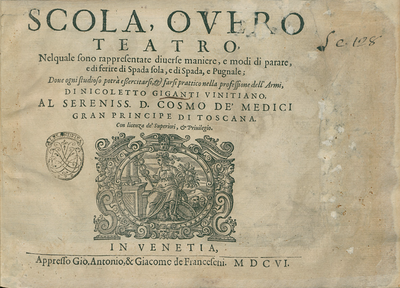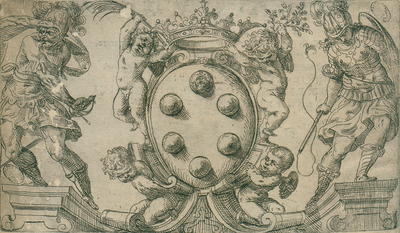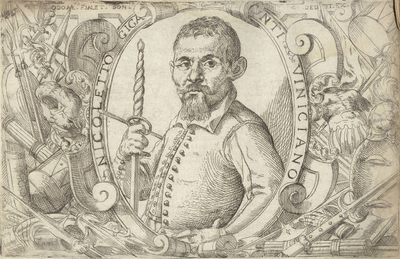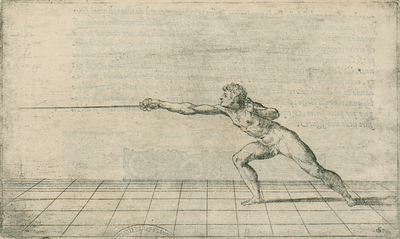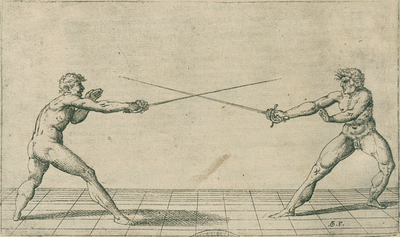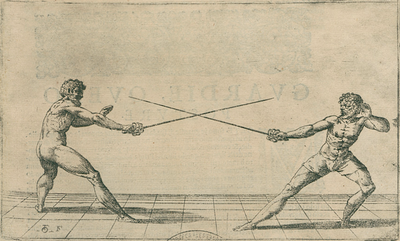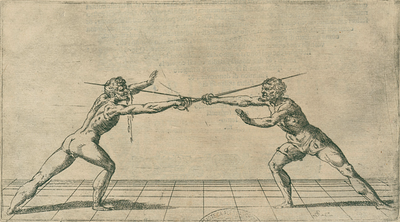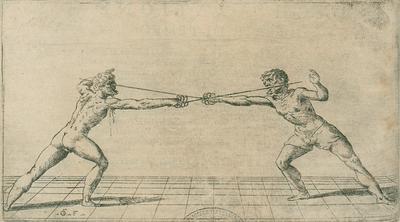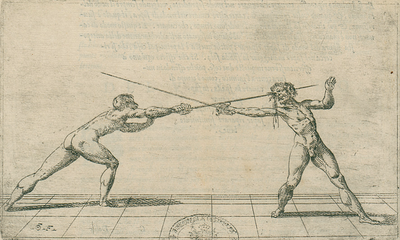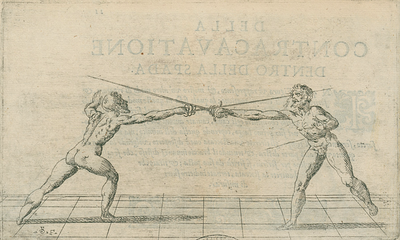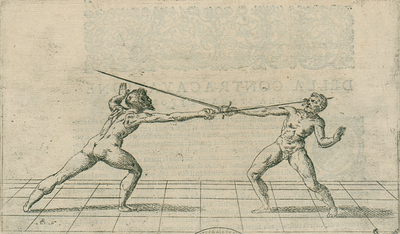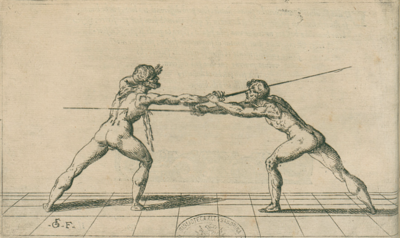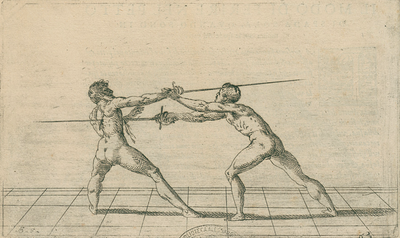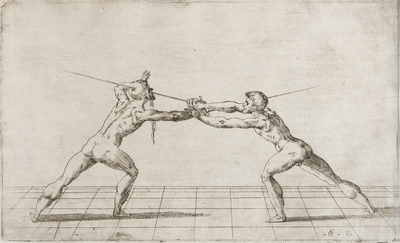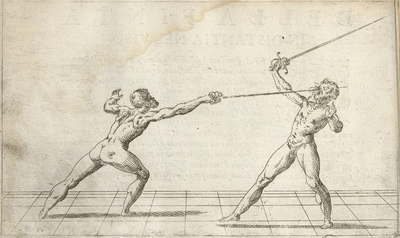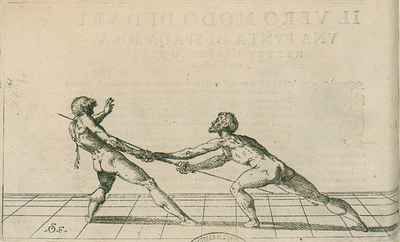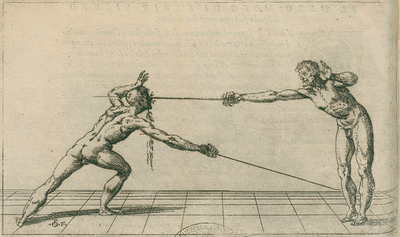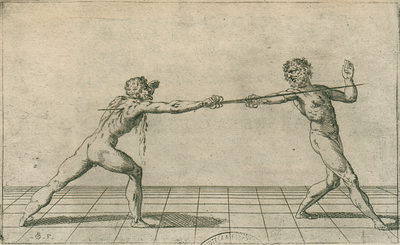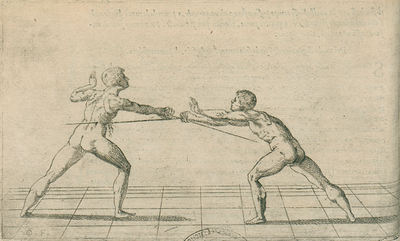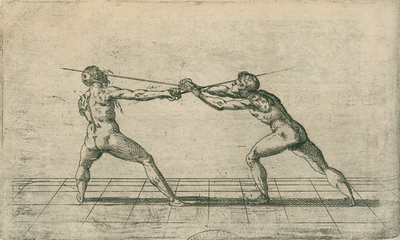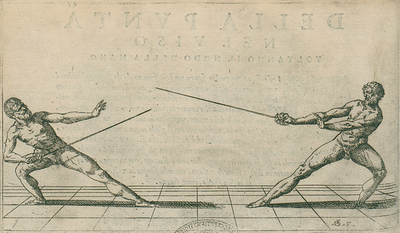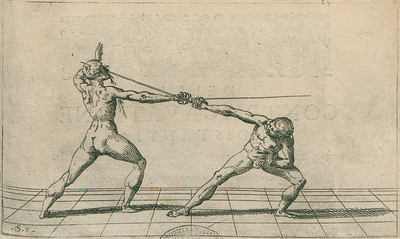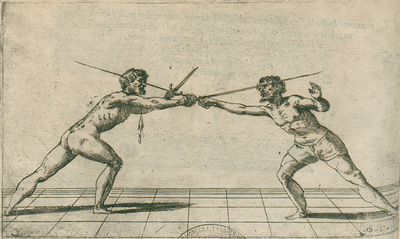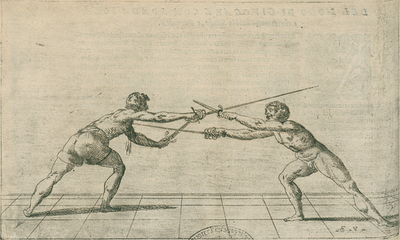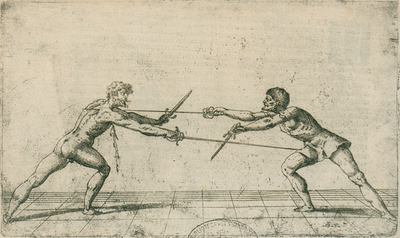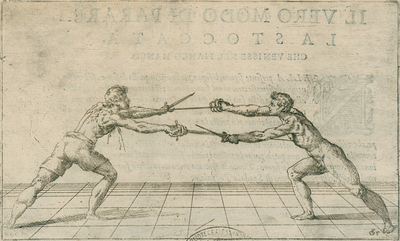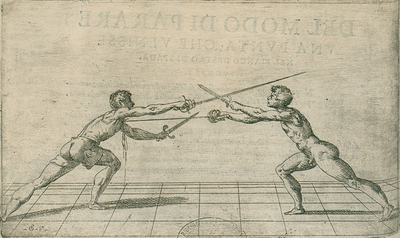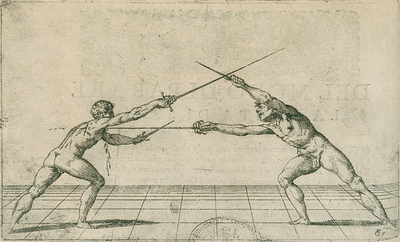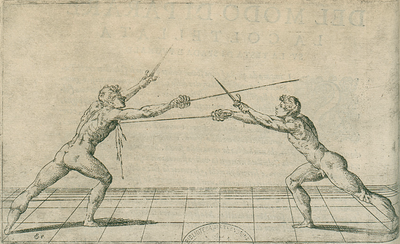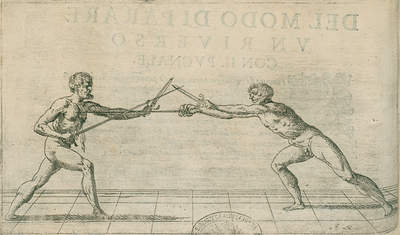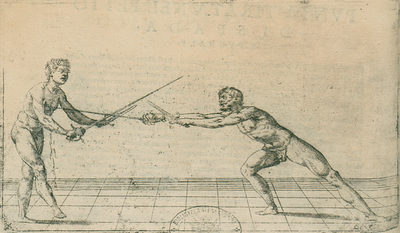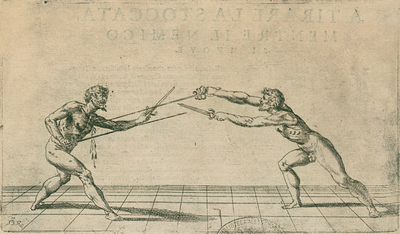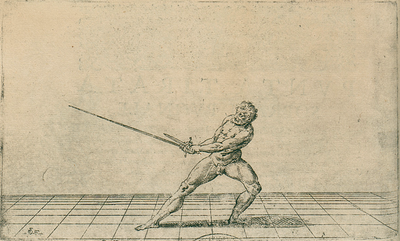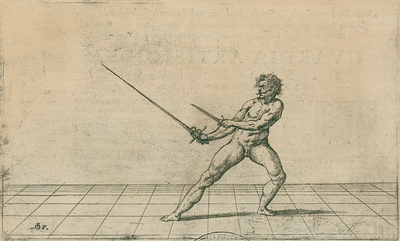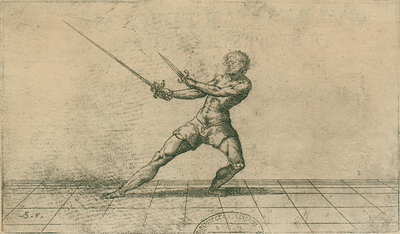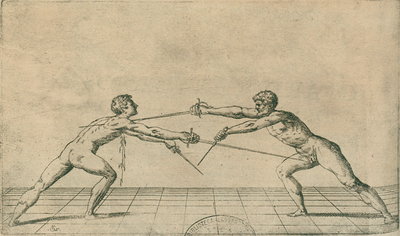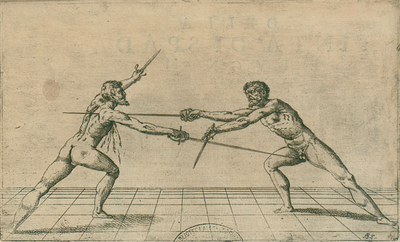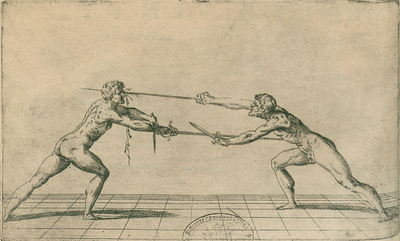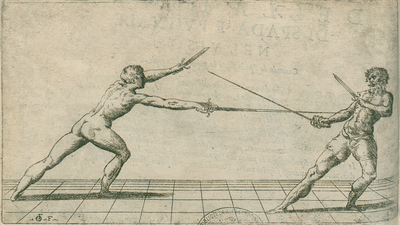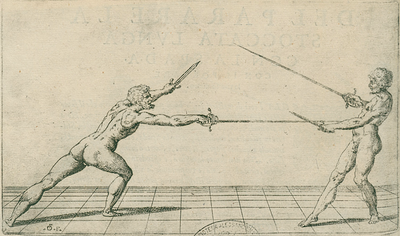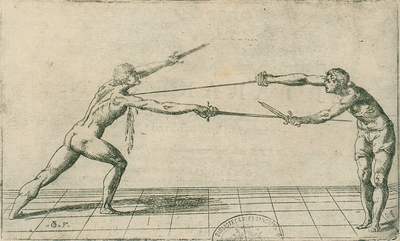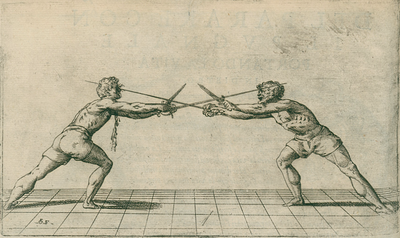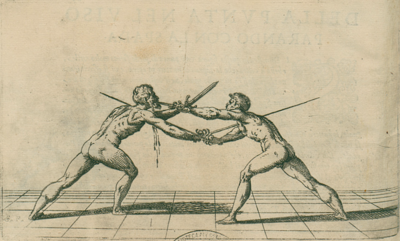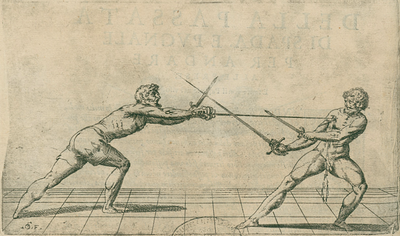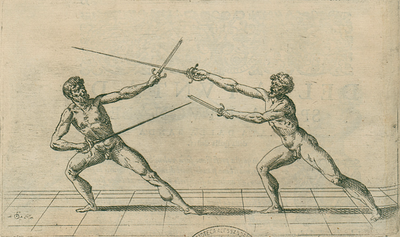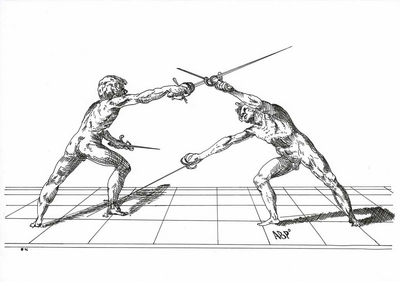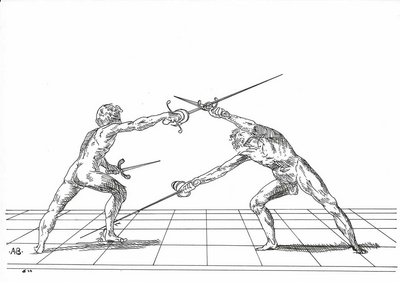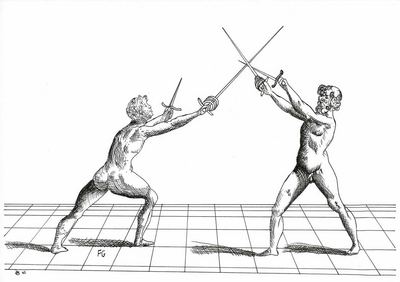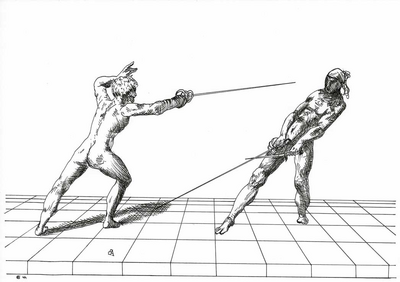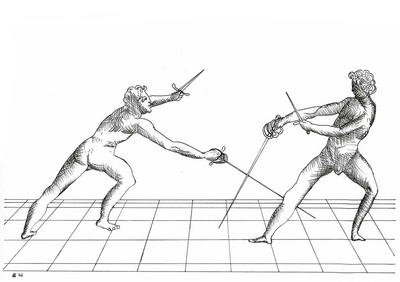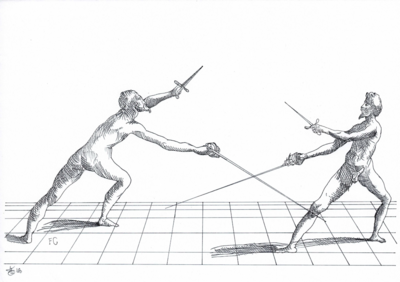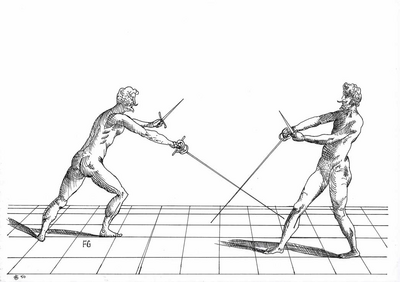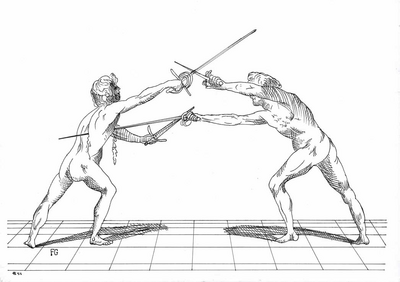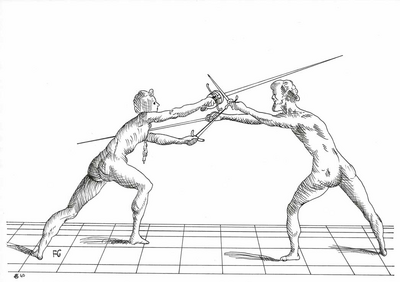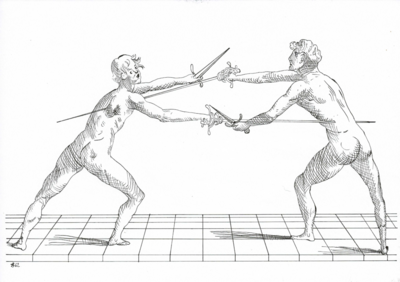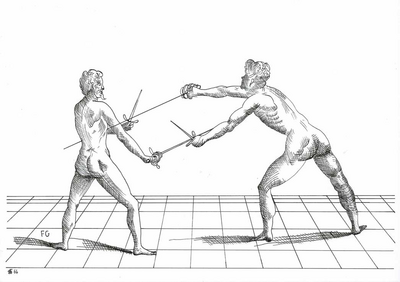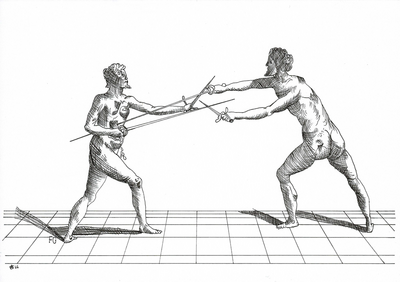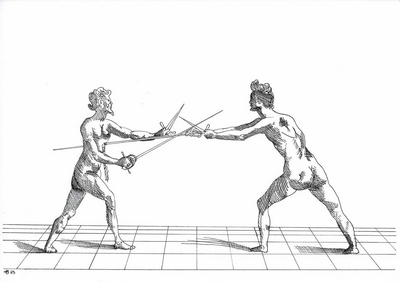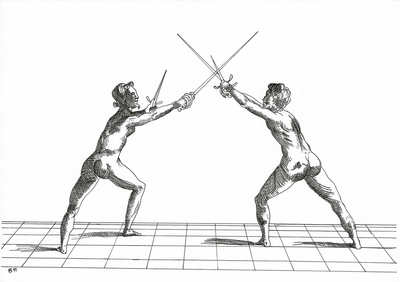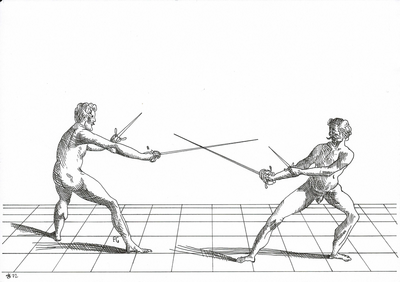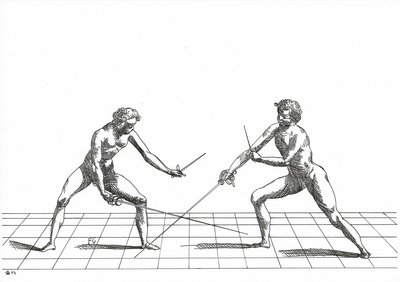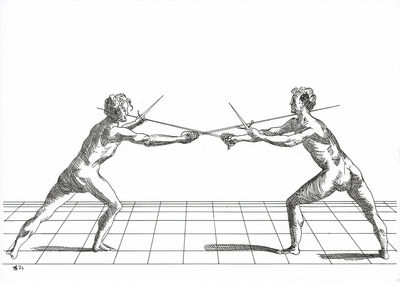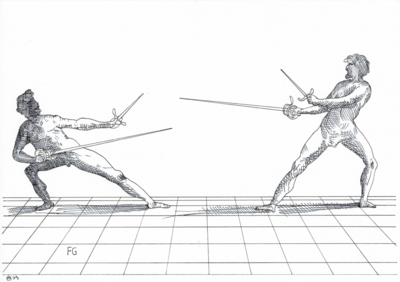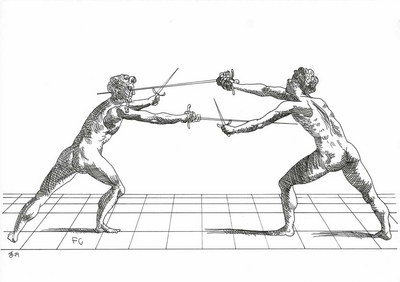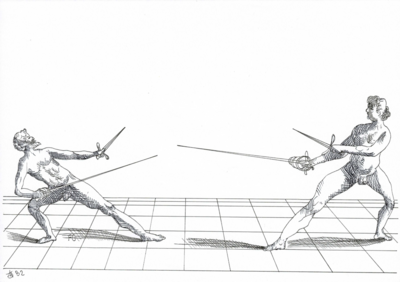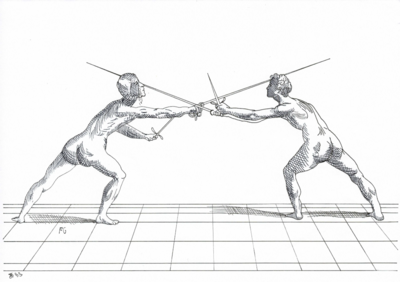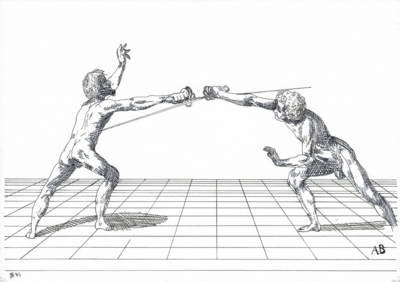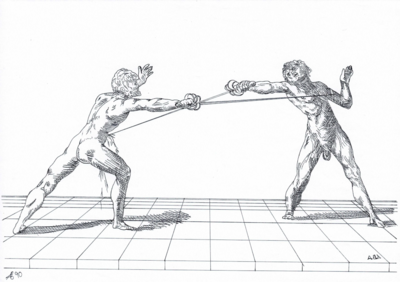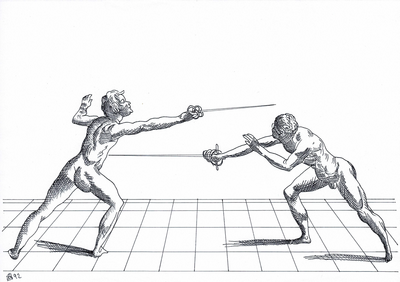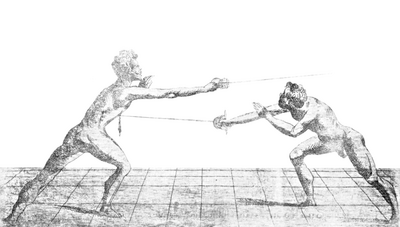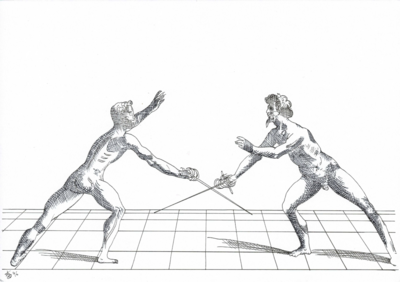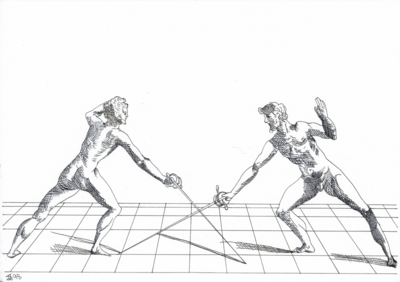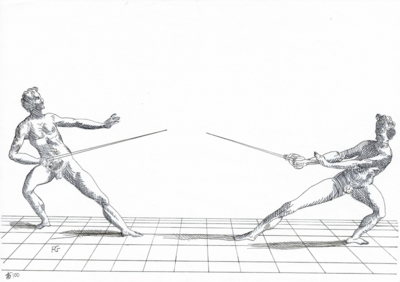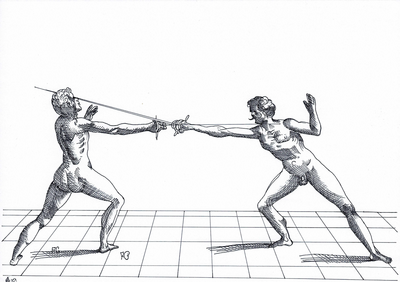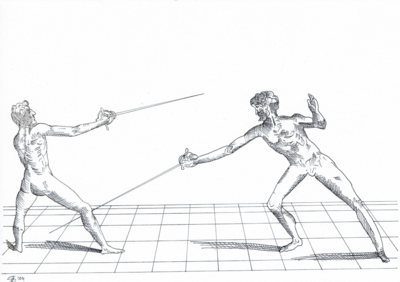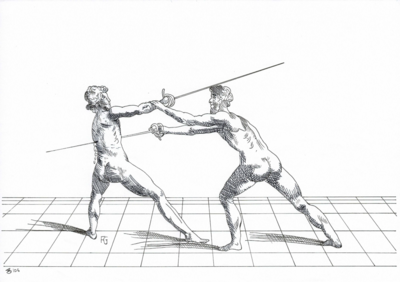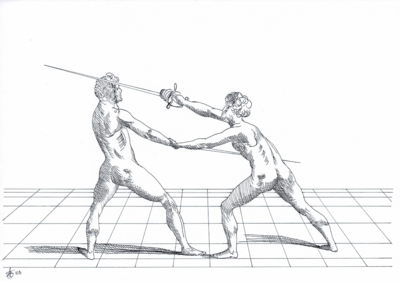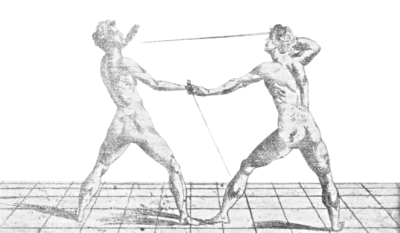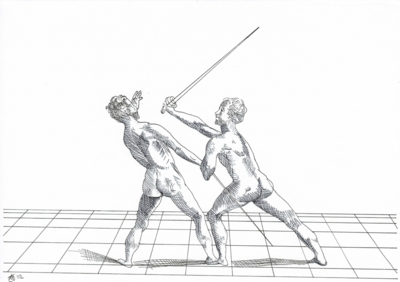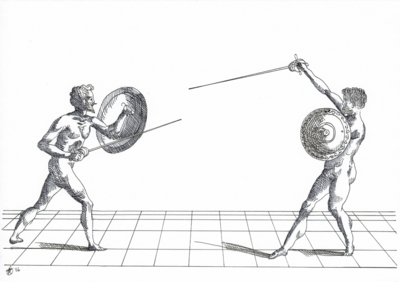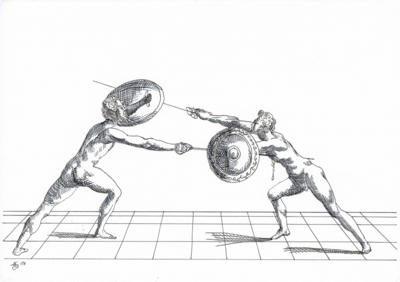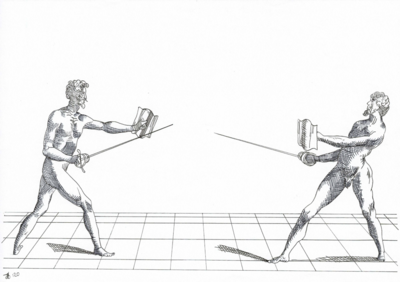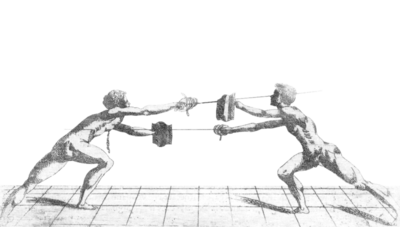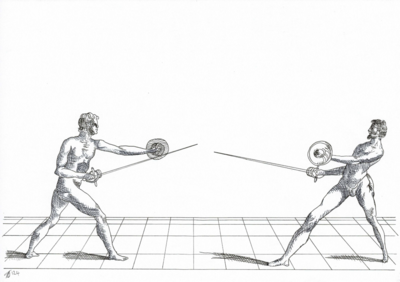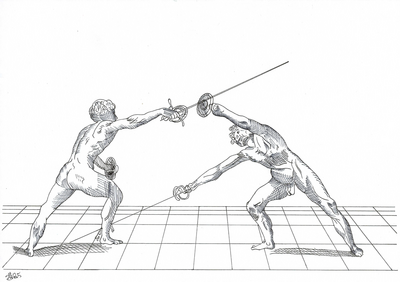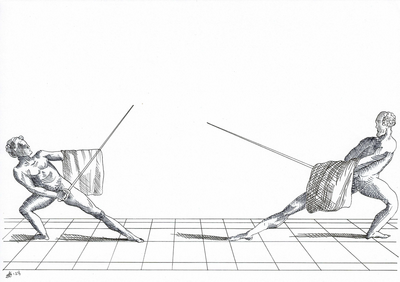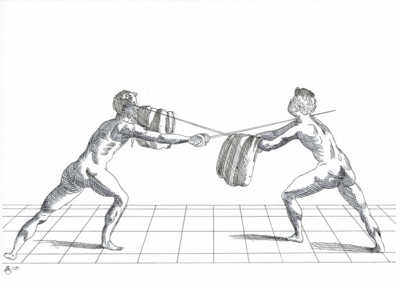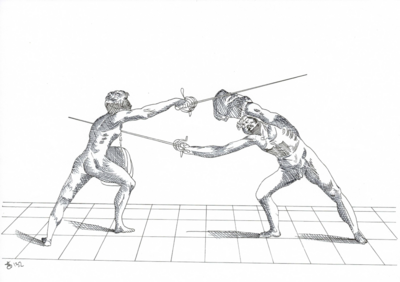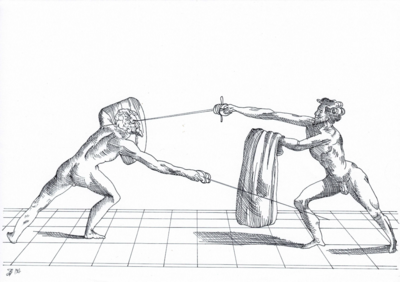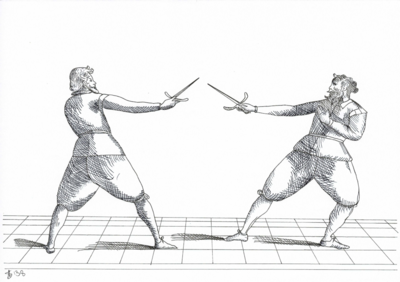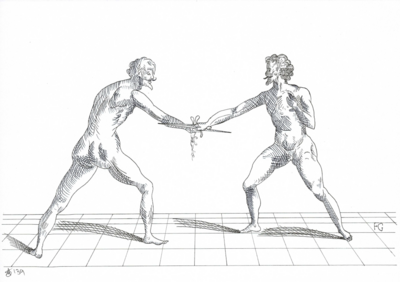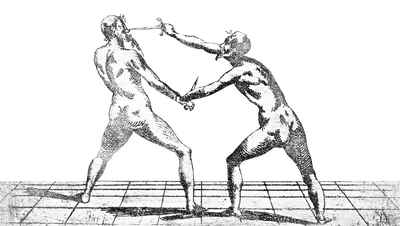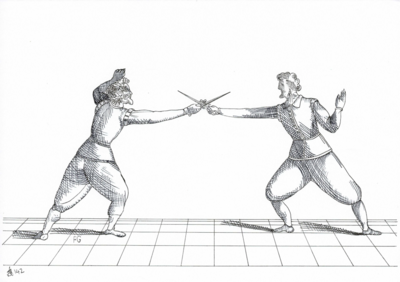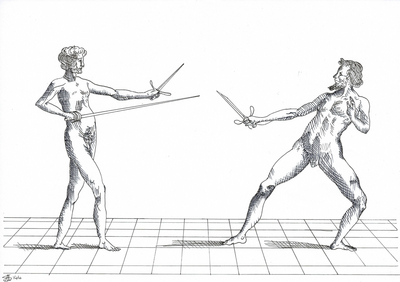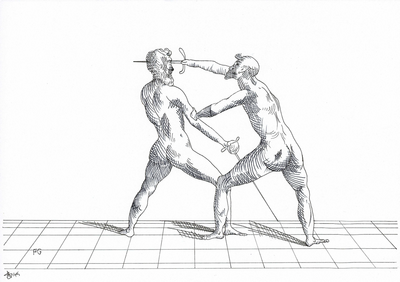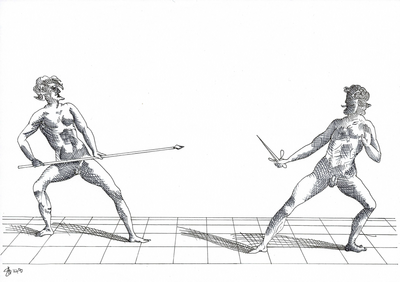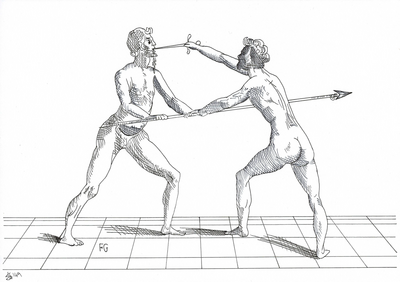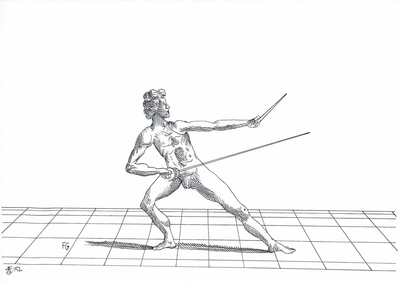|
|
You are not currently logged in. Are you accessing the unsecure (http) portal? Click here to switch to the secure portal. |
Difference between revisions of "Nicoletto Giganti"
| (9 intermediate revisions by the same user not shown) | |||
| Line 51: | Line 51: | ||
| below = | | below = | ||
}} | }} | ||
| − | '''Nicoletto Giganti''' (Niccoletto, Nicolat) was an [[nationality::Italian]] soldier and [[fencing master]] around the turn of the [[century::17th century]]. He was likely born to a noble family in Fossombrone in central Italy,<ref name="Terminiello 9"> | + | '''Nicoletto Giganti''' (Niccoletto, Nicolat) was an [[nationality::Italian]] soldier and [[fencing master]] around the turn of the [[century::17th century]]. He was likely born to a noble family in Fossombrone in central Italy,<ref name="Terminiello 9">Giganti 2013, p 9.</ref> and only later became a citizen of Venice.<ref>That he eventually became a Venetian citizen is indicated on the [[Page:Scola, overo teatro (Nicoletto Giganti) 1606.pdf/5|title page]] of his 1606 treatise.</ref> Little is known of Giganti’s life, but in the dedication to his 1606 treatise he claims 27 years of professional experience, meaning that his career began in 1579 (possibly referring to service in the Venetian military, a long tradition of the Giganti family).<ref name="Terminiello 9"/> Additionally, the preface to his 1608 treatise describes him as a Master of Arms to the Order of Santo Stefano in Pisa, a powerful military order founded by Cosimo I de' Medici, giving some further clues to his career. |
| − | In 1606, Giganti published a treatise on the use of the rapier (both single and with the dagger) titled ''[[Scola, overo teatro (Nicoletto Giganti)|Scola, overo teatro]]'' ("School, or Theater"). It is dedicated to Cosimo II de' Medici. This treatise is structured as a series of progressively more complex lessons, and Tom Leoni opines that this treatise is the best pedagogical work on rapier fencing of the early 17th century.<ref> | + | In 1606, Giganti published a treatise on the use of the rapier (both single and with the dagger) titled ''[[Scola, overo teatro (Nicoletto Giganti)|Scola, overo teatro]]'' ("School, or Theater"). It is dedicated to Cosimo II de' Medici. This treatise is structured as a series of progressively more complex lessons, and Tom Leoni opines that this treatise is the best pedagogical work on rapier fencing of the early 17th century.<ref>Giganti 2010, p xi.</ref> It is also the first treatise to fully articulate the principle of the lunge. Giganti also promised in this book that he would publish a second volume, a pledge he made good on in 1608.<ref>This treatise was considered lost for centuries, and as early as 1673 the Sicilian master [[Giuseppe Morsicato Pallavicini]] stated that this second book was never published at all. See ''[[La seconda parte della scherma illustrata (Giuseppe Morsicato Pallavicini)|La seconda parte della scherma illustrata]]''. Palermo, 1673. p V.</ref> Titled ''[[Libro secondo (Nicoletto Giganti)|Libro secondo di Niccoletto Giganti]]'' ("Second Book of Niccoletto Giganti"), it is dedicated to Christofano Chigi, a Knight of Malta, and covers the same weapons as the first as well as rapier and buckler, rapier and cloak, rapier and shield, single dagger, and mixed weapon encounters. This text in turn promises additional writings on the dagger and on cutting with the rapier, but there is no record of further books by Giganti ever being published. |
| − | + | While Giganti's second book quickly disappeared from history, his first seems to have been quite popular: reprints, mostly unauthorized, sprang up many times over the subsequent decades, both in the original Italian and, beginning in 1619, in French and German translations. The 1622 edition of this unauthorized dual-language edition also included book 2 of [[Salvator Fabris]]' 1606 treatise ''[[Scienza d’Arme (Salvator Fabris)|Lo Schermo, overo Scienza d’Arme]]''<ref>It's possible that the 1619 did as well, but there are no surviving copies that include it so we have to assume it didn't.</ref> which, coupled with the loss of Giganti's true second book, is probably what has lead many later bibliographers to accuse Giganti himself of plagiarism.<ref>This accusation was first made by [[Johann Joachim Hynitzsch]], who attributed the edition to Giganti rather than Zeter and was incensed that he gave no credit to Fabris.</ref> | |
| − | |||
| − | While Giganti's second book quickly disappeared from history, his first seems to have been quite popular: reprints, mostly unauthorized, sprang up many times over the subsequent decades, both in the original Italian and, beginning in 1619, in French and German translations. | ||
== Treatise == | == Treatise == | ||
| − | Giganti, like many 17th century authors, had a tendency to write incredibly long, multi-page paragraphs which quickly become hard to follow. Jacob de Zeter's 1619 dual-language edition often breaks these up into more manageable chunks, and | + | Giganti, like many 17th century authors, had a tendency to write incredibly long, multi-page paragraphs which quickly become hard to follow. Jacob de Zeter's 1619 dual-language edition often breaks these up into more manageable chunks, and in this concordance his paragraph breaks have also been applied to the Italian and English. |
| − | |||
| − | |||
| − | + | A [http://data.onb.ac.at/rep/109AF678 copy of the 1628 printing] of the first book which now resides in the [[Österreichische Nationalbibliothek]] was extensively annotated by a contemporary reader. Its annotations are beyond the scope of this concordance, but they have been [http://www.rapier.at/2018/07/20/a-transcription-of-annotations-in-the-onb-copy-211216-c-of-scola-overo-teatro-by-nicoletto-giganti/ transcribed] by [[Julian Schrattenecker]] and [[Florian Fortner]], and incorporated into [[Jeff Vansteenkiste]]'s translation in a [https://labirinto.ca/translations/ separate document]. | |
{{master begin | {{master begin | ||
| Line 705: | Line 701: | ||
|- | |- | ||
| rowspan="2" | [[File:Giganti 15.png|400x400px|center|Figure 15]] | | rowspan="2" | [[File:Giganti 15.png|400x400px|center|Figure 15]] | ||
| − | | <p>[41] '''The Inquartata''' or Slip of the Vita</p> | + | | <p>[41] '''The ''Inquartata''''' or Slip of the Vita</p> |
<p>Knowing the ''inquartata'', or slip, is necessary for mastering the body. However, this is not ordinarily used in schools, except by the French in order to exercise the ''vita''. Truthfully, many are these slips, or ''inquartate'', but I decided to show only three of them in this, my first book—in my view the safest and most beautiful, as revealed in the present figure.</p> | <p>Knowing the ''inquartata'', or slip, is necessary for mastering the body. However, this is not ordinarily used in schools, except by the French in order to exercise the ''vita''. Truthfully, many are these slips, or ''inquartate'', but I decided to show only three of them in this, my first book—in my view the safest and most beautiful, as revealed in the present figure.</p> | ||
| Line 750: | Line 746: | ||
| <p>[46] ''The method of playing single sword against single sword with resolute thrusts''</p> | | <p>[46] ''The method of playing single sword against single sword with resolute thrusts''</p> | ||
| − | <p>In schools, there are many who resolutely come throwing thrusts, imbroccate, and cuts when they assail the enemy, giving no ''tempo'' and always throwing with fury and very great impetus. These things ordinarily confound and disorder every beautiful player and fencer, for which reason it is necessary to know how to defend oneself in such an occasion.</p> | + | <p>In schools, there are many who resolutely come throwing thrusts, ''imbroccate'', and cuts when they assail the enemy, giving no ''tempo'' and always throwing with fury and very great impetus. These things ordinarily confound and disorder every beautiful player and fencer, for which reason it is necessary to know how to defend oneself in such an occasion.</p> |
| {{section|Page:Scola, overo teatro (Nicoletto Giganti) 1606.pdf/61|2|lbl=-}} | | {{section|Page:Scola, overo teatro (Nicoletto Giganti) 1606.pdf/61|2|lbl=-}} | ||
| | | | ||
| Line 1,176: | Line 1,172: | ||
{| class="master" | {| class="master" | ||
|- | |- | ||
| − | ! <p>Illustrations<br/> | + | ! <p>Illustrations<br/>from the 1608</p> |
! <p>{{rating|C}}<br/>by [[Jeff Vansteenkiste]]</p> | ! <p>{{rating|C}}<br/>by [[Jeff Vansteenkiste]]</p> | ||
! <p>[[Libro secondo (Nicoletto Giganti)|First Edition]] (1608){{edit index|Libro secondo (Nicoletto Giganti) 1608.pdf}}<br/>Transcribed by [[Benjamin Keiller]]</p> | ! <p>[[Libro secondo (Nicoletto Giganti)|First Edition]] (1608){{edit index|Libro secondo (Nicoletto Giganti) 1608.pdf}}<br/>Transcribed by [[Benjamin Keiller]]</p> | ||
| Line 1,228: | Line 1,224: | ||
{| class="master" | {| class="master" | ||
|- | |- | ||
| − | ! <p>Illustrations<br/> | + | ! <p>Illustrations<br/>from the 1608</p> |
! <p>{{rating|C}}<br/>by [[Jeff Vansteenkiste]]</p> | ! <p>{{rating|C}}<br/>by [[Jeff Vansteenkiste]]</p> | ||
! <p>[[Libro secondo (Nicoletto Giganti)|First Edition]] (1608){{edit index|Libro secondo (Nicoletto Giganti) 1608.pdf}}<br/>Transcribed by [[Benjamin Keiller]]</p> | ! <p>[[Libro secondo (Nicoletto Giganti)|First Edition]] (1608){{edit index|Libro secondo (Nicoletto Giganti) 1608.pdf}}<br/>Transcribed by [[Benjamin Keiller]]</p> | ||
|- | |- | ||
| − | | | + | | <p style="text-align: center;"><br/><br/><br/><br/>[Portrait of Nicoletto Giganti]</p> |
| <p>'''Preface to the Lord Readers'''</p> | | <p>'''Preface to the Lord Readers'''</p> | ||
| − | <p>''It being the case that in my first book I discussed throwing the firm-footed thrust, and feints, and taught to defend against all the stoccate, in this, my second, I thought to be more universal, intending to teach you additional types of weapons and, more importantly, how all sorts of cuts are defended against and how they must be thrown, the method of passing with the foot, and everything in accordance with what I promised you in my First Book.''<p> | + | <p>''It being the case that in my first book I discussed throwing the firm-footed thrust, and feints, and taught to defend against all the ''stoccate'', in this, my second, I thought to be more universal, intending to teach you additional types of weapons and, more importantly, how all sorts of cuts are defended against and how they must be thrown, the method of passing with the foot, and everything in accordance with what I promised you in my First Book.''<p> |
<p>''It is necessary that someone who wishes to become perfect in the profession of arms not only know how to throw a thrust well, perform a beautiful feint, and pass well with both the right and left foot, but also that he know the counter to all these things—that is, how to gracefully defend against them. That given, someone who knows how to throw a thrust well and how to perform a pass but is then lacking in knowledge of how to defend can be said to know nothing, because if he disputes with another who knows how to throw a thrust as he does, both will be wounded. Thus, it is good to know how to throw a thrust and perform a pass but much better to know how to defend against it, as we will discuss in this book.''</p> | <p>''It is necessary that someone who wishes to become perfect in the profession of arms not only know how to throw a thrust well, perform a beautiful feint, and pass well with both the right and left foot, but also that he know the counter to all these things—that is, how to gracefully defend against them. That given, someone who knows how to throw a thrust well and how to perform a pass but is then lacking in knowledge of how to defend can be said to know nothing, because if he disputes with another who knows how to throw a thrust as he does, both will be wounded. Thus, it is good to know how to throw a thrust and perform a pass but much better to know how to defend against it, as we will discuss in this book.''</p> | ||
| − | <p>''Additionally, someone who is a valiant man in throwing a thrust and passing and also knows how to defend against all kinds of passes and feints but is lacking in throwing and defending against cuts is understood to know nothing. This is because if he contends with someone who does not know how to fence with the sword, as one mostly finds these days, he will have to know how to parry cuts, since the instincts of these such who have no knowledge naturally throw many cuts. Even though someone who knows how to throw a thrust who contends with someone who does not will strike him with a stoccata, in the same tempo that other person throws a cut at him, whence both will be struck. As many thrusts as the person who knows how to throw a thrust throws at him, that many cuts the other will throw at his head or legs, trained thus by nature. Given that, both would be in danger, and for this reason knowing how to throw a stoccata is not sufficient. Knowing how to parry cuts is very useful, though. Therefore, I encourage everyone who wishes to learn this virtue of fencing to learn to throw everything, thrust and cut, and further, to learn to defend against thrusts and cuts of all kinds well.''</p> | + | <p>''Additionally, someone who is a valiant man in throwing a thrust and passing and also knows how to defend against all kinds of passes and feints but is lacking in throwing and defending against cuts is understood to know nothing. This is because if he contends with someone who does not know how to fence with the sword, as one mostly finds these days, he will have to know how to parry cuts, since the instincts of these such who have no knowledge naturally throw many cuts. Even though someone who knows how to throw a thrust who contends with someone who does not will strike him with a ''stoccata'', in the same tempo that other person throws a cut at him, whence both will be struck. As many thrusts as the person who knows how to throw a thrust throws at him, that many cuts the other will throw at his head or legs, trained thus by nature. Given that, both would be in danger, and for this reason knowing how to throw a ''stoccata'' is not sufficient. Knowing how to parry cuts is very useful, though. Therefore, I encourage everyone who wishes to learn this virtue of fencing to learn to throw everything, thrust and cut, and further, to learn to defend against thrusts and cuts of all kinds well.''</p> |
<p>''Three kinds of cuts are thrown.''</p> | <p>''Three kinds of cuts are thrown.''</p> | ||
| Line 1,263: | Line 1,259: | ||
{| class="master" | {| class="master" | ||
|- | |- | ||
| − | ! <p>Illustrations<br/> | + | ! <p>Illustrations<br/>from the 1608</p> |
! <p>{{rating|C}}<br/>by [[Jeff Vansteenkiste]]</p> | ! <p>{{rating|C}}<br/>by [[Jeff Vansteenkiste]]</p> | ||
! <p>[[Libro secondo (Nicoletto Giganti)|First Edition]] (1608){{edit index|Libro secondo (Nicoletto Giganti) 1608.pdf}}<br/>Transcribed by [[Benjamin Keiller]]</p> | ! <p>[[Libro secondo (Nicoletto Giganti)|First Edition]] (1608){{edit index|Libro secondo (Nicoletto Giganti) 1608.pdf}}<br/>Transcribed by [[Benjamin Keiller]]</p> | ||
| Line 1,289: | Line 1,285: | ||
<p>If an unarmoured gentleman with only sword and dagger were by chance [attacked] by an armoured enemy with a heavy sword, attempting to parry with the dagger would be dangerous. This is because without gauntlets there is no doubt that if the hand catches it, the dagger will be thrown to the ground or, instead, the dagger will not withstand the great blow. Attempting to parry with the sword works well, but he will not be able to wound his adversary without notable danger because someone who is armoured has more courage than someone who is not, and more daringly drives himself forward and redoubles the cuts, which would endanger someone who is unarmoured. It can therefore be done in this way.</p> | <p>If an unarmoured gentleman with only sword and dagger were by chance [attacked] by an armoured enemy with a heavy sword, attempting to parry with the dagger would be dangerous. This is because without gauntlets there is no doubt that if the hand catches it, the dagger will be thrown to the ground or, instead, the dagger will not withstand the great blow. Attempting to parry with the sword works well, but he will not be able to wound his adversary without notable danger because someone who is armoured has more courage than someone who is not, and more daringly drives himself forward and redoubles the cuts, which would endanger someone who is unarmoured. It can therefore be done in this way.</p> | ||
| − | <p>When the enemy throws the cut at your head, parry with the sword and dagger crossed as the figure shows, the dagger above and the sword below. In the same tempo, disengage the sword from under that of the enemy and throw a stoccata at his face, and return backward outside of measure. Parry and throw stoccate at his face in this way as many times as the adversary throws. A hundred cuts can be parried in this way and it is easy to wound him in the face because, throwing the cut, he comes forward with his face and head much more as the gentleman throws the stoccata as an imbroccata, extending the foot and then withdrawing outside of measure.</p> | + | <p>When the enemy throws the cut at your head, parry with the sword and dagger crossed as the figure shows, the dagger above and the sword below. In the same tempo, disengage the sword from under that of the enemy and throw a ''stoccata'' at his face, and return backward outside of measure. Parry and throw ''stoccate'' at his face in this way as many times as the adversary throws. A hundred cuts can be parried in this way and it is easy to wound him in the face because, throwing the cut, he comes forward with his face and head much more as the gentleman throws the ''stoccata'' as an ''imbroccata'', extending the foot and then withdrawing outside of measure.</p> |
| | | | ||
{{pagetb|Page:Libro secondo (Nicoletto Giganti) 1608.pdf|12|lbl=9|p=1}} {{pagetb|Page:Libro secondo (Nicoletto Giganti) 1608.pdf|13|lbl=10|p=1}} | {{pagetb|Page:Libro secondo (Nicoletto Giganti) 1608.pdf|12|lbl=9|p=1}} {{pagetb|Page:Libro secondo (Nicoletto Giganti) 1608.pdf|13|lbl=10|p=1}} | ||
| Line 1,295: | Line 1,291: | ||
|- | |- | ||
| | | | ||
| − | | <p>[4] '''Method of Parrying with the Sword and Dagger Crossed and Throwing a ''Riverso'' at the Leg'''</p> | + | | <p>[4] '''The Method of Parrying with the Sword and Dagger Crossed and Throwing a ''Riverso'' at the Leg'''</p> |
<p>It is also quite safe to parry cuts in this way: When your enemy throws the cut at you parry in the above way, and in the same instant let a ''riverso'' go toward his leg so that he cannot parry it and keep his sword in your dagger. Most importantly, parrying, throwing the ''riverso'', and withdrawing outside of measure are done in the same tempo. You can parry in this manner as many times as he throws at you and throw the ''riverso'' at his leg or thrust at his face as above. | <p>It is also quite safe to parry cuts in this way: When your enemy throws the cut at you parry in the above way, and in the same instant let a ''riverso'' go toward his leg so that he cannot parry it and keep his sword in your dagger. Most importantly, parrying, throwing the ''riverso'', and withdrawing outside of measure are done in the same tempo. You can parry in this manner as many times as he throws at you and throw the ''riverso'' at his leg or thrust at his face as above. | ||
| Line 1,303: | Line 1,299: | ||
|- | |- | ||
| rowspan="2" | [[File:Giganti 1608 04.png|400px|center|border]] | | rowspan="2" | [[File:Giganti 1608 04.png|400px|center|border]] | ||
| − | | <p>[5] '''Method of Defending Against Cuts by Voiding the ''Vita'''''</p> | + | | <p>[5] '''The Method of Defending Against Cuts by Voiding the ''Vita'''''</p> |
| − | <p>This figure shows you that if your enemy throws a cut at your head, you must pull your ''vita'' backward in the same tempo, as the figure shows you, let the cut fall in vain, in the same instant throw a stoccata where you see the adversary is most uncovered, and return immediately outside of measure. The stoccata will be safe because the more strongly your enemy throws, the more he uncovers himself, and he then recovers with greater difficulty. You can also throw this thrust if your enemy were to throw a ''riverso'' at your head. While he throws the ''riverso'', bring your ''vita'' back and throw the stoccata as above, and quickly return backward outside of measure.</p> | + | <p>This figure shows you that if your enemy throws a cut at your head, you must pull your ''vita'' backward in the same tempo, as the figure shows you, let the cut fall in vain, in the same instant throw a ''stoccata'' where you see the adversary is most uncovered, and return immediately outside of measure. The ''stoccata'' will be safe because the more strongly your enemy throws, the more he uncovers himself, and he then recovers with greater difficulty. You can also throw this thrust if your enemy were to throw a ''riverso'' at your head. While he throws the ''riverso'', bring your ''vita'' back and throw the ''stoccata'' as above, and quickly return backward outside of measure.</p> |
| {{section|Page:Libro secondo (Nicoletto Giganti) 1608.pdf/16|1|lbl=13.1}} | | {{section|Page:Libro secondo (Nicoletto Giganti) 1608.pdf/16|1|lbl=13.1}} | ||
|- | |- | ||
| − | | <p>[6] '''Method of Defending Against Cuts by Voiding the ''Vita'' and Throwing the Cut at the Leg'''</p> | + | | <p>[6] '''The Method of Defending Against Cuts by Voiding the ''Vita'' and Throwing the Cut at the Leg'''</p> |
<p>Further, it is good and safe in this way: We suppose that your enemy throws a cut at your head, your ''vita'' brought back in the above way, and, while the cut passes by, you throw a ''riverso'' at his leg, which will strike him safely so that he cannot defend from it. The harder he throws, the worse it is for him. If he were to throw a ''riverso'' at you, bringing your ''vita'' backward, give him a ''mandritto'' to the leg because when someone throws a ''mandritto'', the ''riverso'' is eluded by the ''mandritto''. Given that, if your enemy throws a ''riverso'', you must throw a ''mandritto'', and if he throws a ''mandritto'' at you, you must throw a ''riverso'', taking care to keep your sword high and that your blow travels in the same tempo that the adversary’s sword passes by, so that he will therefore have no tempo to parry it. As soon as you have thrown, return outside of measure with your weapons ready to parry and wound.</p> | <p>Further, it is good and safe in this way: We suppose that your enemy throws a cut at your head, your ''vita'' brought back in the above way, and, while the cut passes by, you throw a ''riverso'' at his leg, which will strike him safely so that he cannot defend from it. The harder he throws, the worse it is for him. If he were to throw a ''riverso'' at you, bringing your ''vita'' backward, give him a ''mandritto'' to the leg because when someone throws a ''mandritto'', the ''riverso'' is eluded by the ''mandritto''. Given that, if your enemy throws a ''riverso'', you must throw a ''mandritto'', and if he throws a ''mandritto'' at you, you must throw a ''riverso'', taking care to keep your sword high and that your blow travels in the same tempo that the adversary’s sword passes by, so that he will therefore have no tempo to parry it. As soon as you have thrown, return outside of measure with your weapons ready to parry and wound.</p> | ||
| {{section|Page:Libro secondo (Nicoletto Giganti) 1608.pdf/16|2|lbl=13.2}} | | {{section|Page:Libro secondo (Nicoletto Giganti) 1608.pdf/16|2|lbl=13.2}} | ||
| + | |||
| + | |- | ||
| + | | [[File:Giganti 1608 05.png|400px|center|border]] | ||
| + | | <p>[7] '''The Method with which Cuts to the Leg are Defended Against'''</p> | ||
| + | |||
| + | <p>We have shown how cuts to the head are defended against. Now the ordering requires that we teach how cuts toward the leg are defended against. Therefore, this figure shows you that if your enemy were to come to throw you a cut at your leg, in the same tempo you parry with the edge, or rather, ''forte'', of your sword and immediately throw a ''riverso'' at his face, because only a ''riverso'' can be extracted from parrying according to the method in the figure. Then, immediately return backward outside of measure.</p> | ||
| + | | {{pagetb|Page:Libro secondo (Nicoletto Giganti) 1608.pdf|18|lbl=15}} | ||
| + | |||
| + | |- | ||
| + | | [[File:Giganti 1608 06.png|400px|center|border]] | ||
| + | | <p>[8] '''Another Method of Defending with the Sword Against Cuts to the Leg'''</p> | ||
| + | |||
| + | <p>Cuts toward the leg can also be parried with the sword in this other way, if need be. If you were to throw a ''stoccata'' at your enemy and he parries it and in the same tempo throws a cut at your leg, it is necessary to parry it with the sword as the figure shows. As soon as you have parried, it is necessary that you throw a thrust at your enemy’s face because if he throws at your leg he must lower his head, whence it will be easy for you to catch his face and wound him. Then, immediately return from it backward outside of measure in the above way.</p> | ||
| + | | {{pagetb|Page:Libro secondo (Nicoletto Giganti) 1608.pdf|20|lbl=17}} | ||
| + | |||
| + | |- | ||
| + | | [[File:Giganti 1608 07.png|400px|center|border]] | ||
| + | | <p>[9] '''The Method of Defending With the Sword Against the ''Riverso'' to the Leg'''</p> | ||
| + | |||
| + | <p>This is a safe way of parrying a ''riverso'' at the leg. While your enemy throws this ''riverso'' at you, parry with the edge of the sword, turning your wrist, and immediately throw a thrust by way of ''imbroccata'' at his face. It can occur that when you throw a ''stoccata'', your enemy parries it. In the instant he throws a ''riverso'' at your leg, parry with your sword in the above way, throw the ''stoccata'' at his face, and immediately return outside of measure.</p> | ||
| + | | {{pagetb|Page:Libro secondo (Nicoletto Giganti) 1608.pdf|22|lbl=19}} | ||
| + | |||
| + | |- | ||
| + | | | ||
| + | | <p>[10] '''Preface on the Properties of Cuts to the Lord Readers'''<br/><br/></p> | ||
| + | |||
| + | <p>In this, my Second Book, I did not intend to discuss cuts further because it would produce too large a volume if I wished to put all the ways they can be performed into figures. I will only briefly touch on all the ways that one can wound with cuts and how they must be defended against. Then, in another book that I will shortly publish, if it pleases the Lord, I will discuss the trickeries and deceptions that can be performed in throwing cuts. Therefore, I will say only this: In contending with or playing at arms, be advised not to throw both in the same tempo, but wait until the adversary’s cut to your leg or head has been defended from and then wound safely as said above. If the same enemy waits in guard for you to throw, however, you must throw at the part that appears most uncovered, taking care that your dagger or sword guards against the adversary’s sword while you throw, so that if he were also to throw in the same tempo you are able to parry and return outside of measure. I wish to teach you to defend yourself with cuts against two or three people in cases of necessity. If you are assaulted by two people, it often happens that if you throw a ''mandritto'' at one, the other throws at you in that tempo, and if you throw a ''stoccata'' at the other, you encounter a ''stoccata'' from the first. You would thus quickly find yourself dead, as has happened to many. Therefore, in order to defend yourself and offend, I want you to hold the sword high as if to throw a ''mandritto''. If both were to throw a ''stoccata'' at you in the same instant, throw a ''mandritto'' and then a ''riverso'' onto the swords. The ''mandritto'' must be thrown in this way: So that it almost wounds the enemy’s neck and arrives at your left side to wound again. This manner of ''mandritto'' produces two effects: it wounds and parries in the same tempo. The ''mandritto'' thrown, the ''vita'' and foot can be drawn back along with putting the sword under the left arm in order to throw the ''riverso''. Then immediately throw the ''riverso'' in this way: So that it begins wounding the adversary’s neck and arrives to wound anew at your right flank—which is to say the ''mandritto'' and ''riverso'' wound in the form of a cross. One parries and wounds in this way because your sword must necessarily find the enemies’ weapons, taking care that such ''mandritti'' and ''riversi'' must be thrown long, strong, quick, and wide, and must never stop at all. Rather, as soon as the ''mandritto'' is thrown it is necessary that the ''riverso'' occurs, and thus, on the contrary, as soon as the ''riverso'' is thrown do not delay at all in throwing the ''mandritto''. In conclusion, all must be performed like a wheel.</p> | ||
| + | |||
| + | <p>To throw this kind of cut, it is necessary to practise throwing ''mandritti'' and ''riversi'' in order to prepare the arm and quicken and invigorate the leg by throwing two or three hundred cuts and, likewise, ''riversi'', without ever stopping. Everyone will thus also be able to parry all the ''stoccate'' of three or four, both wounding and keeping their enemies at a sword’s length by throwing long, quick, strong, and wide. This kind of cut has this property: If a gentleman were to find himself unarmoured with only a sword and is assaulted by his enemy, fully armoured and with sword and dagger who comes at him with ''stoccate'' and ''imbroccate'', he will be able to defend his body in this way: He holds his sword as I said above, high as if to throw a cut, and while his enemy throws a cut he throws a ''mandritto'' at the enemy’s sword and immediately throws a ''riverso'' at his head or legs, then immediately returns backward outside of measure. This is for the reason that, throwing a ''mandritto'' onto the sword while the enemy throws the ''stoccata'', his sword will be thrown to the ground, and before [the enemy] recovers [the gentleman] will be able to throw not a single ''riverso'', but two or three, then return backward. If the enemy were to throw a hundred ''stoccate'' in a row at him, [the gentleman] will parry them all safely and be able to wound his enemy with the ''riverso'' to the face or leg. Furthermore, the cut thrown in this manner also has this property: That if an adversary were to throw said ''imbroccata'' or ''stoccata'', throwing a ''mandritto'' to parry it and finding the enemy’s arm weakened from having thrown the ''stoccata'', it will be easy to make the sword fall from his hand. Therefore, I urge everyone to practise this method of throwing cuts because it defends and wounds safely and other [methods] do not, as they only wound but do not defend if the enemy were to throw in the same tempo.</p> | ||
| + | | | ||
| + | {{pagetb|Page:Libro secondo (Nicoletto Giganti) 1608.pdf|24|lbl=21|p=1}} {{pagetb|Page:Libro secondo (Nicoletto Giganti) 1608.pdf|25|lbl=22|p=1}} {{pagetb|Page:Libro secondo (Nicoletto Giganti) 1608.pdf|26|lbl=23|p=1}} | ||
| + | |||
| + | |- | ||
| + | | [[File:Giganti 1608 08.png|400px|center|border]] | ||
| + | | <p>[11] '''The Method of Parrying a ''Stoccata'' that Comes''' at the Face on the Outside</p> | ||
| + | |||
| + | <p>In my first book I promised you that I would discuss how one passes with the foot in order to attempt to wound, being that in it I only spoke of the firm-foot, with which someone knows how to play well and recognize the tempo. He will do those same things when passing. Therefore, I ready myself to keep the promise. If your enemy were to throw at you, whatever blow he wishes, either thrust or cut, you can pass with the foot, knowing how to take the tempo. When you have passed, disengage the sword, throw two or three ''stoccate'' , and immediately return backward outside of measure, as you will learn in this figure, which shows you that, being in guard with your right foot forward, if your enemy were to throw a thrust on the outside of your dagger, in the same tempo you parry with the dagger, pass your left foot forward, and throw the ''stoccata'' in the same tempo, as the figure shows. Once you have thrown the ''stoccata'', it is necessary to withdraw the ''vita'', disengage the sword, keep the dagger firm on your enemy’s sword, throw two or three ''stoccate'', and withdraw outside of measure. Take care in leaping backward, however, to secure yourself with your sword on his so that in returning outside of measure your adversary does not throw you a ''stoccata'' where you are most uncovered, thus wounding you both, as often occurs. If in returning backward you place your sword over his, however, he will not be able to wound you. Therefore, I urge you in all passes you perform to keep your sword over the enemy’s until you are outside of measure again, because someone who knows how to perform a pass but does not know how to then disengage the sword and wound again or to escape from the enemy’s weapons can be said to be ignorant of this profession. This is for the reason that if they pass with the foot they come to grips and both end up in no small amount of danger if they do not know the method of doing so. Performing these kinds of passes, then, is not for everyone. Rather, it is only for those who are strong and dexterous, who know how to play from a firm foot well so that they recognize the tempo and measure, and who are well-practised, because it cannot be said that I wish to pass at the onset. First it is necessary to see what the enemy does, the tempo and occasion must be taken according to this, recognizing when it is time to throw from a firm foot, when from a pass, when with a ''stoccata'', and when with a cut.</p> | ||
| + | | | ||
| + | {{pagetb|Page:Libro secondo (Nicoletto Giganti) 1608.pdf|28|lbl=25|p=1}} {{pagetb|Page:Libro secondo (Nicoletto Giganti) 1608.pdf|29|lbl=26|p=1}} {{pagetb|Page:Libro secondo (Nicoletto Giganti) 1608.pdf|30|lbl=27|p=1}} | ||
| + | |||
| + | |- | ||
| + | | [[File:Giganti 1608 09.png|400px|center|border]] | ||
| + | | <p>[12] '''The Method of Performing a Pass with the Foot when the Enemy''' Throws a Thrust on the Inside at the Face</p> | ||
| + | |||
| + | <p>This figure shows you that if you are in guard with your right foot forward and your enemy throws a thrust at your face, you must parry with the dagger and in the same tempo pass with the left foot and throw a ''stoccata'' at the flank, as the figure shows, and immediately secure yourself well over your feet and disengage your sword and throw two or three ''stoccate'' while holding your dagger firm over your enemy’s sword. If he were to try to disengage it in order to throw additional blows, it is necessary that you follow it with the dagger while continuing to throw ''stoccate'' and return backward outside of measure, securing yourself with your sword over his.</p> | ||
| + | | {{pagetb|Page:Libro secondo (Nicoletto Giganti) 1608.pdf|32|lbl=29}} | ||
| + | |||
| + | |- | ||
| + | | [[File:Giganti 1608 10.png|400px|center|border]] | ||
| + | | <p>[13] '''The Method of Performing a Pass with the Foot, Throwing a Thrust at the Enemy’s Chest'''</p> | ||
| + | |||
| + | <p>This figure shows you that if your enemy were to throw a thrust at your chest, you parry it with the dagger and in the same tempo pass with the foot and wound with a thrust, as the figure shows you. The ''stoccata'' thrown, disengage the sword and return outside of measure, securing yourself with your sword over his and keeping the weapons ready to parry and wound.</p> | ||
| + | | {{pagetb|Page:Libro secondo (Nicoletto Giganti) 1608.pdf|34|lbl=31}} | ||
| + | |||
| + | |- | ||
| + | | [[File:Giganti 1608 11.png|400px|center|border]] | ||
| + | | <p>[14] '''The Method of Passing Onto the Enemy, Him Standing in Guard Uncovered on the Right Side'''</p> | ||
| + | |||
| + | <p>Given that one can pass when the adversary throws whatever blow he wishes, thrust or cut, the enemy standing in whatever guard he wishes, you are able to pass, taking heed of what guard he places himself in, considering where he is most uncovered and what side to assail him on, taking care to watch where the enemy’s sword is so that you are able to impede it while you pass so he does not wound and offend you. This figure shows that if your enemy were to stand in a guard that was uncovered on the right side, it would be necessary to bind him on the outside and when you are at measure, if he stays still in guard, it is necessary to throw the ''stoccata'', pass with the foot, and place your dagger over the enemy’s sword. These things must be done in the same tempo. In the case that the enemy were to disengage in order to wound you while you put your dagger on his sword, follow it while you wound. The first ''stoccata'' thrown, disengage the sword, pull yourself outside of measure, and secure yourself in the above way. Adding here that if the enemy parries your first ''stoccata'', you would be in parity.</p> | ||
| + | | {{pagetb|Page:Libro secondo (Nicoletto Giganti) 1608.pdf|36|lbl=33}} | ||
| + | |||
| + | |- | ||
| + | | [[File:Giganti 1608 12.png|400px|center|border]] | ||
| + | | <p>[15] '''The Proper Method of Passing with the Foot and Wounding Over the Dagger'''</p> | ||
| + | |||
| + | <p>I believe you will recognize that this figure shows you how to wound over the dagger. That given, as you can see, your enemy is in a guard with his dagger low, with the sword however he wishes—high or low does not matter because your dagger must always guard against his sword, and where you see it you must always go and bind him little by little to guard against it. When you are at measure, if he stands in guard to wait for you, throw the ''stoccata'' strongly, passing with the foot with your dagger on the enemy’s sword, as you see in the figure. To perform these passes most perfectly, it is necessary that when you are at measure you throw the arm first and then pass with the foot, which strikes him with the ''stoccata'' so quickly that he does not perceive it, as I fully demonstrated in my First Book. Take care that when your enemy stands in whatever guard he wishes that you go to bind him, and when you are at measure intending to pass you watch that he does not throw at you in that tempo. If you see that he wishes to throw, however, be careful to parry his ''stoccata'' first, then pass as we said above.</p> | ||
| + | | {{pagetb|Page:Libro secondo (Nicoletto Giganti) 1608.pdf|38|lbl=35}} | ||
| + | |||
| + | |- | ||
| + | | [[File:Giganti 1608 13.png|400px|center|border]] | ||
| + | | <p>[16] '''The Method of Passing When the Enemy has Uncovered His Chest'''</p> | ||
| + | |||
| + | <p>If your enemy has uncovered his chest, his sword high or low, and stands in guard in order to wait for you, in a narrow guard with the sword inside go to bind him little by little until you are at measure. When you are at the designated point, pass in the above way, first throwing the sword arm where he is most uncovered, then passing with the foot, securing yourself from the enemy sword with your dagger as above, throwing the same ''stoccate'' and escaping in the same way. In this Second Book I did not wish to produce more than these three lessons for wounding when the enemy is in guard waiting for you, which, if I am not mistaken, will illuminate for you how to understand proceeding to pass in all guards that the enemy can produce by making use of the said method.</p> | ||
| + | | {{pagetb|Page:Libro secondo (Nicoletto Giganti) 1608.pdf|40|lbl=37}} | ||
| + | |||
| + | |- | ||
| + | | [[File:Giganti 1608 14.png|400px|center|border]] | ||
| + | | <p>[17] '''The Method of Parrying the Cut at the Head and Passing with the Foot, Crossing the Sword and Dagger'''</p> | ||
| + | |||
| + | <p>This figure shows you that if your enemy were to throw a cut at your head, you must parry crossed, pass with the foot, give him a ''riverso'' to the leg along with three or four ''stoccate'', and escape. It is done in this way: Standing in guard with the right foot forward, forward so that your enemy throws a cut at your head, cross the sword and dagger and go to meet the ''mandritto'', passing with your left foot as you see in the figure, and immediately throw the ''riverso'' at his leg along with pulling back the ''vita'', so that the adversary’s sword will remain on your dagger, throw three or four ''stoccate'', and return outside of measure, securing your sword over his in the above way.</p> | ||
| + | | {{pagetb|Page:Libro secondo (Nicoletto Giganti) 1608.pdf|42|lbl=39}} | ||
| + | |||
| + | |- | ||
| + | | [[File:Giganti 1608 15.png|400px|center|border]] | ||
| + | |||
| + | |||
| + | [[File:Giganti 1608 16.png|400px|center|border]] | ||
| + | | <p>[18] '''The Method of Proceeding against all Guards and Wounding in Many Ways While the Enemy Disengages the Sword'''</p> | ||
| + | |||
| + | <p>In these four figures I want to show you how one proceeds against every kind of guard. Two figures show you how one binds, the others how one wounds, because a valiant man who is a good and practised fencer will never endanger himself, but will be alert to what the enemy does and see to binding him against his guard. Advancing against the guards is done in this way: Finding the adversary in whatever guard he wishes, high or low or with the sword extended, cover the enemy’s sword with yours but in a way that he cannot wound if he does not disengage the sword, like you see with the two figures. After you have gone to cover the sword so that he cannot offend you if he does not disengage you are safe from every offence, since in disengaging it he can end up wounded in many manners, as you will learn. Finding your enemy with his sword forward, go to bind him with your sword on his like you see in the first figure. If your enemy were to disengage the sword in order to wound you, turn your wrist and parry strongly with your arm extended until the adversary’s sword is on the ground, as you see in the figure. In the same tempo, pass with the foot, place the dagger on the enemy’s sword and, throwing two or three ''stoccate'' at him, escape in the above way, securing yourself with your sword on his. This manner of wounding is performed when the enemy is in guard with the sword forward: Go to bind him with your sword on his, and if you see that he does not wish to disengage his sword and stays firm in guard, then disengage yours narrowly, parrying strongly with your arm, and pass with your left foot until the enemy’s sword is on the ground. Then you can place your dagger on his sword, throw some ''stoccate'', and escape in the described way. Many things can be done when proceeding to bind your enemy in the way of the first two figures. If your enemy disengages the sword yet stays still in guard, go to bind him gently and when you are at measure throw with a firm foot where he is most uncovered and escape. You can pass with artifices you have learned. You can also do this: As you advance to bind your enemy, if the adversary disengages the sword in order to wound your face when you are at measure, parry in the same tempo with the dagger and, passing with the foot, throw your ''stoccata'' at his chest, keeping in mind that you must perform all three of these things in one same tempo—that is, while your enemy throws the thrust at your face, you must parry with the dagger, pass with the foot, and throw the ''stoccata''. Otherwise, the pass would not succeed. After, withdraw the ''vita'', throw two or three ''stoccate'', and escape in the above way.</p> | ||
| + | | | ||
| + | {{pagetb|Page:Libro secondo (Nicoletto Giganti) 1608.pdf|45|lbl=42|p=1}} {{pagetb|Page:Libro secondo (Nicoletto Giganti) 1608.pdf|46|lbl=43|p=1}} | ||
| + | |||
| + | |- | ||
| + | | [[File:Giganti 1608 17.png|400px|center|border]] | ||
| + | | <p>[19] '''The Method of Throwing the ''Punta Riversa'' at the Face'''</p> | ||
| + | |||
| + | <p>This is another kind of wound called a “''punta''”, which is performed in many ways. I will speak to you about this artifice alone. If your enemy were found in guard with the right foot forward and is desirous to wound you, also place yourself with your right foot forward and uncover your chest in order to give him an opportunity to throw at you. Hold the point of your sword toward his left flank so that the enemy guards against your sword with his dagger, and as the adversary throws the ''stoccata'', parry with the dagger and pass with your left foot, throwing the ''stoccata'' on the outside of his sword at his face as you see the figure. This manner of wounding greatly deceives the enemy because, holding the sword toward his left side, he will watch to parry it with the dagger, imagining that when you have parried you will throw the straight ''stoccata'' like he threw his. Whence, he is surprised to find the sword in his face. Having thrown the ''stoccata'', disengage the sword, withdraw your ''vita'', place your dagger on his sword, throw some ''stoccate'', and escape in the above way.</p> | ||
| + | | {{pagetb|Page:Libro secondo (Nicoletto Giganti) 1608.pdf|48|lbl=45}} | ||
| + | |||
| + | |- | ||
| + | | [[File:Giganti 1608 18.png|400px|center|border]] | ||
| + | |||
| + | [[File:Giganti 1608 19.png|400px|center|border]] | ||
| + | | <p>[20] '''Artificial Guard for Defending Against Furious Passes of the Left or Right Foot'''</p> | ||
| + | |||
| + | <p>After you have learned to perform all kinds of passes it is necessary to learn how they must be defended against. If by chance someone knew fencing as well as or better than you and was stronger and more dexterous, it would be necessary to make use of the arts of deception, for the reason that it is not enough to know how to throw a graceful thrust, a feint, or a pass, but one must also make use of trickeries and deceptions, and to know from those how to be watchful in occasions, because the flower of this science boils down to trickery and deception. I will demonstrate that such is true thus: If two masters play, they do not make use of either thrusts or cuts, but of the usefulness of new trickeries and deceptions. These figures show you that if your enemy were with his left foot forward due to wishing to pass onto you, when he approaches binding you, place yourself in a guard with the right foot forward, artfully uncover your chest, and give him an opportunity to throw at your chest as you see with the first figures. Be careful that you do not let him come inside measure, and when you see that your enemy wishes to pass, parry with your dagger in the same tempo and bring back your right foot, ending up with your left foot forward as the second figure shows you. The enemy having passed and become similarly disconcerted, having parried his ''stoccata'' you will find it easy to give him as many ''stoccate'' as you wish. Give him the first thrust while he passes, parrying in the same tempo, bringing your ''vita'' and step backward and wounding. Then you can immediately disengage the sword again and, when you have thrown the ''stoccate'' you wish, return backward outside of measure and escape in the way mentioned above.</p> | ||
| + | | | ||
| + | {{pagetb|Page:Libro secondo (Nicoletto Giganti) 1608.pdf|51|lbl=48|p=1}} {{pagetb|Page:Libro secondo (Nicoletto Giganti) 1608.pdf|52|lbl=49|p=1}} | ||
| + | |||
| + | |- | ||
| + | | [[File:Giganti 1608 20.png|400px|center|border]] | ||
| + | |||
| + | |||
| + | [[File:Giganti 1608 21.png|400px|center|border]] | ||
| + | | <p>[21] '''Another Method of Artificial Guards for Deceiving the Enemy''' When He Wishes to Pass with his Right or Left Foot</p> | ||
| + | |||
| + | <p>These figures are another way of deceiving the enemy when he wishes to pass onto you with either the right or left foot because even though these figures are seen with the left foot forward, they can nevertheless be defended against in the same way as the passes with the right foot forward. If you see your enemy wishes to come upon you with their left or right foot forward, place yourself in guard with the right foot forward, uncover your chest, and give him an opportunity to move to wound you. In that instant, in the same tempo he throws the ''stoccata'', parry with the sword, bring your foot and ''vita'' back, and wound like the figure. Immediately place your dagger on your enemy’s sword, throw the ''stoccate'' you wish, and return backward outside of measure and escape in the way repeatedly described.</p> | ||
| + | | | ||
| + | {{pagetb|Page:Libro secondo (Nicoletto Giganti) 1608.pdf|55|lbl=52|p=1}} {{pagetb|Page:Libro secondo (Nicoletto Giganti) 1608.pdf|56|lbl=53|p=1}} | ||
| + | |||
| + | |} | ||
| + | {{master subsection end}} | ||
| + | |||
| + | {{master subsection begin | ||
| + | | title = Rapier | ||
| + | | width = 90em | ||
| + | }} | ||
| + | {| class="master" | ||
| + | |- | ||
| + | ! <p>Illustrations<br/>from the 1608</p> | ||
| + | ! <p>{{rating|C}}<br/>by [[Jeff Vansteenkiste]]</p> | ||
| + | ! <p>[[Libro secondo (Nicoletto Giganti)|First Edition]] (1608){{edit index|Libro secondo (Nicoletto Giganti) 1608.pdf}}<br/>Transcribed by [[Benjamin Keiller]]</p> | ||
| + | |||
| + | |- | ||
| + | | [[File:Giganti 1608 22.png|400px|center|border]] | ||
| + | | <p>[22] '''An Artificial Method of Parrying with the Single Sword'''</p> | ||
| + | |||
| + | <p>In my First Book I showed how one must proceed with the single sword to bind the enemy, covering his sword, and, while he disengages his sword, wound him. This figure now shows you another way of wounding with artifice. It is this: Your enemy seen in a guard with the sword forward, go to bind him with yours over his in the way of the first figures of my First Book and, your enemy wishing to wound you, it is necessary that he disengage his sword. While he disengages the sword, lift your fist and drop your ''vita'' and the point of your sword so that you strike him in the flank, which he will be unable to parry because he believes you must parry with your fist low and point high. Doing it as I have said, you strike him unexpectedly. The ''stoccata'' thrown, return backward outside of measure, securing yourself by placing your sword over his.</p> | ||
| + | | {{pagetb|Page:Libro secondo (Nicoletto Giganti) 1608.pdf|58|lbl=55}} | ||
| + | |||
| + | |- | ||
| + | | [[File:Giganti 1608 23.png|400px|center|border]] | ||
| + | | <p>[23] '''Another Artificial Method of Wounding, Going to Bind''' the Enemy on the Outside of His Sword</p> | ||
| + | |||
| + | <p>The previous figure went to bind the enemy on the inside of the sword and wounded on the outside. The current [figure] is of going to bind on the outside of the sword. It is done in this way: Go to bind the enemy on the outside of the sword, with your sword over his, and give him occasion to disengage the sword in order to wound you. While he disengages the sword, you parry, lifting your wrist and lowering your ''vita'' and the point of the sword, as you seen in the figure, which will deceive him. The ''stoccata'' thrown, return backward outside of measure in the said way.</p> | ||
| + | | {{pagetb|Page:Libro secondo (Nicoletto Giganti) 1608.pdf|60|lbl=57}} | ||
| + | |||
| + | |- | ||
| + | | [[File:Giganti 1608 24.png|400px|center|border]] | ||
| + | | <p>[24] '''The Proper Method of Defending from the ''Inquartata'' With the Void of the ''Vita'''''</p> | ||
| + | |||
| + | <p>Everyone who desires to become perfect in this profession, in addition to knowing how to carry the ''vita'' well, parry well, and control the the sword, also needs to know how to void ''stoccate'' with the ''vita'' because it is not always possible to parry with the sword, and in case of necessity, recognizing the danger, one must void the ''vita''. I want to teach you two ways to defend from ''stoccate'' by voiding the ''vita'' and wounding the enemy. It is done in this way: Go to bind your enemy on the outside with your sword over his, stand with your ''vita'' straight, and give him occasion to wound you by ''inquartata''. In the tempo that he disengages his sword to wound you, quickly lower your ''vita'' so that his ''stoccata'' will miss and in the same tempo disengage the sword under the enemy’s sword hand so that you wound him in the flank, as you see the figure. Immediately place your left hand on the hilt of the enemy’s sword and disengage your sword so that you can wound with two or three ''stoccate'' and return immediately outside of measure, as usual.</p> | ||
| + | | {{pagetb|Page:Libro secondo (Nicoletto Giganti) 1608.pdf|62|lbl=59}} | ||
| + | |||
| + | |- | ||
| + | | [[File:Giganti 1608 25.png|400px|center|border]] | ||
| + | | <p>[25] '''The Method of Defending from the ''Stoccata'' by Voiding the ''Vita'', Going to''' Bind the Enemy on the Inside</p> | ||
| + | |||
| + | <p>This other figure shows you that if you bind the adversary on the inside of the sword, with your sword over his and your ''vita'' straight, if he wishes to wound you it is necessary that he disengage the sword and turn his wrist in order to secure himself from your sword. Whence you, as soon as he disengages the sword to wound you in the face, disengage your sword under his and lower your ''vita'' so that you strike him in the flank and his ''stoccata'' misses, and immediately place your left hand over the furnishings of his sword, wound, and escape as above.</p> | ||
| + | | {{pagetb|Page:Libro secondo (Nicoletto Giganti) 1608.pdf|64|lbl=61}} | ||
| + | |||
| + | |- | ||
| + | | [[File:Giganti 1608 26.png|400px|center|border]] | ||
| + | | <p>[26] '''A Method Which Can Parry and Give a ''Riverso''''' or Thrust to the Face</p> | ||
| + | |||
| + | <p>This figure shows you an artificial method of parrying and giving a ''riverso'' or, instead, a safe thrust, to the face in this way: If your enemy were eager to wound with a thrust and you stood in a guard with the sword forward, uncover your chest a little so that he comes to throw a ''stoccata''. Parry with the ''forte'' of your sword and extend with the right foot, going to meet his sword and taking it to the ground with your extended arm, the ''forte'' of your sword, and your ''vita'', as you see the figure, so that the enemy’s face is completely uncovered. Whence you can immediately give him a ''riverso'' to the face and return outside of measure, being aware that while the adversary throws the ''stoccata'' at you it is necessary that you parry in the above way and go forward, and while you throw the ''riverso'' you return backward, and you do these two things in the same tempo. Parrying in this manner, you can wound with a thrust and return backward outside of measure.</p> | ||
| + | | {{pagetb|Page:Libro secondo (Nicoletto Giganti) 1608.pdf|66|lbl=63}} | ||
| + | |||
| + | |- | ||
| + | | [[File:Giganti 1608 27.png|400px|center|border]] | ||
| + | | <p>[27] '''An Artificial Way to Parrying and Giving a ''Mandritto''''' or Thrust to the Face</p> | ||
| + | |||
| + | <p>This figure shows you how to strike with a ''mandritto'' or thrust in the face. It is done in this way: It is necessary to place yourself in a guard and uncover your right side a little in order to embolden the enemy so that he throws at that uncovered side with a thrust. Alternatively, if you see that the adversary is in guard with the sword forward, bind him on the inside with your sword and, while he disengages his sword, parry in the above way. While he disengages the sword, extend with your foot and, with your arm extended and the strength of your shoulder and your entire ''vita'', take the enemy’s sword to the ground as the figure shows, whence his face will then be uncovered and you will therefore be able to throw a ''mandritto'' or, instead, a thrust at his face and then return backward outside of measure, taking care to do these things in the same tempo.</p> | ||
| + | | {{pagetb|Page:Libro secondo (Nicoletto Giganti) 1608.pdf|68|lbl=65}} | ||
| + | |||
| + | |- | ||
| + | | [[File:Giganti 1608 28.png|400px|center|border]] | ||
| + | |||
| + | |||
| + | [[File:Giganti 1608 29.png|400px|center|border]] | ||
| + | | <p>[28] '''The Method of Defending from the Pass of the Left Foot at a Distance''' with the Counterdisengage</p> | ||
| + | |||
| + | <p>These figures that you see, one with his left foot forward in order to pass, the other with his right foot forward in order to defend and wound, are very useful, as you will learn. If the enemy were to place himself with his left foot forward in order to wound you and comes to bind you in order to seize the tempo to pass, place yourself in guard with your right foot forward and your sword forward, uncover your right shoulder, and give him a tempo so that he passes because he thinks that you will parry with the edge of your sword and trusts the quickness of throwing a ''stoccata''—that is, that his ''stoccate'' will arrive before you have time to parry. He will succeed every time he is at or inside measure, hence be careful not to let him come inside measure, and when you see he wishes to pass, in the same tempo disengage your sword under his hilt and withdraw the ''vita'' slightly, accompanied by the sword, so that you parry and wound in the same tempo as you see the figure has, and immediately return backward outside of measure with your sword over his.</p> | ||
| + | | | ||
| + | {{pagetb|Page:Libro secondo (Nicoletto Giganti) 1608.pdf|71|lbl=68|p=1}} {{pagetb|Page:Libro secondo (Nicoletto Giganti) 1608.pdf|72|lbl=69|p=1}} | ||
| + | |||
| + | |- | ||
| + | | [[File:Giganti 1608 30.png|400px|center|border]] | ||
| + | | <p>[29] '''The Method of Safely Wounding the Leg with the Single Sword'''</p> | ||
| + | |||
| + | <p>The safe wound to the leg is performed in many ways, which is to say, feigning throwing a cut to the head and while the enemy moves to parry, throwing at the leg. It is necessary that you do not throw at the leg if the enemy’s sword is not seen to pass your ''vita''. Otherwise, you would both strike each other or, if your enemy were to throw over your leg in that tempo, he would strike you in the face and escape, as I said in my First Book. Wishing to safely strike the leg with a ''mandritto'' or ''riverso'', it is necessary to feign throwing naturally at the head with a ''mandritto'' or thrust. If you see that he does not parry resolutely, throwing additional blows to either the leg or elsewhere does not transpire. If you see that he parries, however, let his sword pass your ''vita'' with its point and immediately throw at his leg as you see the figure has, taking care that the feint of either thrust or cut, wounding, and returning backward and escaping are done in the same instant. One can feign in the same way on the outside of the sword and throw a ''riverso''.</p> | ||
| + | | {{pagetb|Page:Libro secondo (Nicoletto Giganti) 1608.pdf|74|lbl=71}} | ||
| + | |||
| + | |- | ||
| + | | [[File:Giganti 1608 31.png|400px|center|border]] | ||
| + | | <p>[30] '''The Method of Coming to Grips and Wounding the Chest with a Thrust'''</p> | ||
| + | |||
| + | <p>We have shown many ways of parrying and wounding with the single sword, in my First just as in this Second Book. It is necessary that we show in what way one fights, coming to grips, and how a man must escape. In this, my Second Book, I wish to teach you only four methods, from which intelligent men can extract many. The proper and safe method of passing at the enemy in order to come to grips is passing, to the inside or outside of the sword, or via the ''inquartata'', as I mentioned in my First Book. By passing on the outside you can come to grips when you like, as you know well, I said in my First Book how to throw a firm-footed thrust on the inside and, as your enemy parries it, disengage the sword to the outside at the enemy’s chest and pass with the left foot in the same tempo. If your enemy is a valiant man he will parry it and you will therefore be with your weapons equal. Whence, I advise you to immediately disengage the sword under the furnishings of his sword while withdrawing your ''vita'' slightly and wound in the chest, as you see the figure has. Holding the enemy’s arm in place with your hand, you can withdraw your ''vita'', disengage your sword, wound two or three times, and return backward outside of measure, securing yourself with your sword over his.</p> | ||
| + | | {{pagetb|Page:Libro secondo (Nicoletto Giganti) 1608.pdf|76|lbl=73}} | ||
| + | |||
| + | |- | ||
| + | | [[File:Giganti 1608 32.png|400px|center|border]] | ||
| + | | <p>[31] '''A Method of Coming to Grips''' and Giving a Cut to the Head</p> | ||
| + | |||
| + | <p>This grip you see is similar to the previous as far as passing, because this is also done with the same pass. After you have passed, then, and you are both with your swords equal, place your left hand on the furnishings of the enemy’s sword, pressing his sword arm with your hand as the present figure shows you, and in the same tempo strike him with a cut to the head that he will doubtless be unable to parry. Give two or three cuts, withdrawing your ''vita'', holding the enemy’s arm in place with your hand. You can give two or three ''stoccate'' and then return backward outside of measure in the above way. Performing these grips consists in knowing well how to seize the tempo to pass safely. It can be seized in many ways, such as uncovering the right side, giving the enemy an opportunity to throw a thrust, and immediately parrying with the ''forte'' of the sword, passing with the foot, straightening the point of the sword at the enemy’s face which, if he does not parry it, will land a thrust on his face and thus nothing further is done. Even if he parries it, though, you will be with your swords equal, and you will come to grips so that the furnishings of your sword make contact with his. Then you will be able to perform all four kinds of grips that I placed in this book. You can also go to bind your enemy on the outside of his sword and pass with the foot, seizing the tempo in the said way, since as long as you have your swords equal you perform one of these four grips—whichever most pleases you. You can also pass safely in this other manner: Go to bind your enemy on the inside with your sword over his and give him occasion to disengage in order to wound you. Then, while he disengages the sword, parry the enemy’s sword with the ''forte'' of your weapons and pass with the foot. Thus, if he does not defend from it, you strike him in the face, and, if he parries, you will be with your weapons equal. Given that, therefore, I said performing these grips consists in knowing how to choose the tempo to pass safely.</p> | ||
| + | | {{pagetb|Page:Libro secondo (Nicoletto Giganti) 1608.pdf|78|lbl=75}} | ||
| + | |||
| + | |- | ||
| + | | [[File:Giganti 1608 33.png|400px|center|border]] | ||
| + | | <p>[32] '''A Method of Grip for Taking the Sword with the Left Hand''' and Striking with a Thrust in the Face</p> | ||
| + | |||
| + | <p>This figure shows you that, having seized the safe tempo in any of the mentioned ways, come to grips, and passed with the foot, being with the weapons equal you must disengage the sword under the furnishings and place your left hand on the inside of the furnishings, turning your arm and hand, seizing the furnishings of your enemy’s sword with your hand as the figure shows. Turning your arm toward his necessitates him to let go of the sword, because while you turn his arm you give him a ''stoccata'' in the face, as you see the figure has, and he loses the strength of his arm from the fear of your sword, whence he is forced to let go of his sword.</p> | ||
| + | | {{pagetb|Page:Libro secondo (Nicoletto Giganti) 1608.pdf|80|lbl=77}} | ||
| + | |||
| + | |- | ||
| + | | [[File:Giganti 1608 34.png|400px|center|border]] | ||
| + | | <p>[33] '''A Method of Grip for Taking the Enemy’s Sword''' and Striking him with the Pommel in the Face</p> | ||
| + | |||
| + | <p>Having come to grips with the weapons equal, wishing to seize the sword from the enemy’s hand and strike him with the pommel in the face, you must do thus: Disengage the sword under the hilt of the enemy’s sword and in the same tempo pull your left arm inside the enemy’s sword and place your left hand on its furnishings, turning your arm toward the enemy’s sword under the left flank as you see the figure has. In the same tempo, strike him with the pommel in the face and, holding the enemy’s sword strongly with your arm, immediately turn your ''vita'' to the right so that the force necessitates him to let go of his sword or have his hand broken, because the force of turning the ''vita'' is very great. For this reason, if your enemy were to have twice your strength, you would take the sword from his hand. These four kinds of grips are only useful to someone who has practised them well, nor should anyone who has only known how to play for a month or two attempt to perform them, because they would not be successful and they would then say that they are not good. I say that these grips are good for those who know how to play firm-footed and with the pass, who recognize tempo and measure, and who are practised with these grips.</p> | ||
| + | | {{pagetb|Page:Libro secondo (Nicoletto Giganti) 1608.pdf|82|lbl=79}} | ||
| + | |||
| + | |- | ||
| + | | | ||
| + | | <p>[34] '''Preface to the Lord Readers'''<p> | ||
| + | |||
| + | <p>In this Second Book, I do not wish to discuss cuts that can be performed with the single sword any further, but you are able to make use of the cuts described for the sword and dagger, such as parrying a cut that comes at the head with the sword and throwing a ''riverso'' at the head or instead at the leg. You can also parry a ''riverso'' to the head and throw a ''mandritto'' at the head or leg. You can even defend against these cuts by voiding the ''vita'', letting the cut pass, and then throwing a thrust or cut, as described in the lessons of the sword and dagger. In contentions with the single sword, it is very safe and good to do it in this way: One stands in a guard with the sword high as if to throw a ''mandritto''. While the adversary throws a ''stoccata'', it is necessary to throw a ''mandritto'' at his sword, and his ''stoccata'' parried thus, it is necessary to immediately throw a ''mandritto'' at his head or leg and return backward outside of measure. It is necessary to parry strongly and then throw as many times as the adversary throws a thrust, so that he is therefore unable to offend. I wish to teach you to throw a ''stoccata'', ''mandritto'', or ''riverso'' with resolute thrusts. It is done in this way: If your enemy were in guard waiting for you, go to bind him where he is uncovered until you are at measure and throw a ''stoccata'', turning your wrist toward the enemy’s sword in order to secure yourself, and if your enemy parries this thrust, throw a ''mandritto'' or ''riverso'' according to how you find yourself—if you throw the ''stoccata'' on the inside, a ''riverso'' will emerge, if you throw on the outside, a ''mandritto''. It is necessary to throw the thrust so that your enemy parries it and throw the ''mandritto'' or ''riverso'' according to how you find yourself in one tempo, because in throwing quickly you will wound, parry, and escape by going out of measure.</p> | ||
| + | | {{pagetb|Page:Libro secondo (Nicoletto Giganti) 1608.pdf|83|lbl=80}} | ||
| + | |||
| + | |} | ||
| + | {{master subsection end}} | ||
| + | |||
| + | {{master subsection begin | ||
| + | | title = Rapier and Other Weapons | ||
| + | | width = 90em | ||
| + | }} | ||
| + | {| class="master" | ||
| + | |- | ||
| + | ! <p>Illustrations<br/>from the 1608</p> | ||
| + | ! <p>{{rating|C}}<br/>by [[Jeff Vansteenkiste]]</p> | ||
| + | ! <p>[[Libro secondo (Nicoletto Giganti)|First Edition]] (1608){{edit index|Libro secondo (Nicoletto Giganti) 1608.pdf}}<br/>Transcribed by [[Benjamin Keiller]]</p> | ||
| + | |||
| + | |- | ||
| + | | | ||
| + | | <p>[35] '''Preface to the Lord Readers'''</p> | ||
| + | |||
| + | <p>All men who know how to play with the single sword and sword and dagger or, rather, who have learned from a good master to carry their ''vita'' and control the sword, and know what tempo and measure are, also know how to play with all types of arms that are in this book, because there is no difference aside from knowing how they are held in the hand and becoming practised with them. Rather, all those things that are done with the sword and the dagger, both thrust and cut, can be very easily performed with sword and rotella, sword and targa, and sword and buckler. As I have said, having learned the single sword is useful for understanding how to defend with the sword. Therefore, I want to show you how these kinds of arms are held in the hand and what properties those who hold them have because, after all, as I said, all that you have learned with the sword the sword and dagger you can do with the sword and rotella, sword and targa, and sword and buckler.</p> | ||
| + | | {{pagetb|Page:Libro secondo (Nicoletto Giganti) 1608.pdf|84|lbl=81}} | ||
| + | |||
| + | |- | ||
| + | | [[File:Giganti 1608 35.png|400px|center|border]] | ||
| + | |||
| + | |||
| + | [[File:Giganti 1608 36.png|400px|center|border]] | ||
| + | | <p>[36] '''The Proper Method of Holding the Rotella'''</p> | ||
| + | |||
| + | <p>These four figures show you how the rotella must be held in the hand. The first two teach how one must stand in guard, and the other two show how one must defend and wound. The rotella is held with the fist upward, as you see in the figure, so that it burdens you less and so that you can more easily defend from all kinds of blows, either thrust or cut. If you were to hold the rotella with the arm extended, as many believe it must be held, you would tire your arm and be endangered. The rotella has wonderful characteristics for someone who knows how to hold it in hand and who is practised because, due to the great size of the rotella, it is easy to defend from both ''mandritto'' and ''riverso'' cuts with it. Every ''stoccata'' that touches it even slightly is defended from and, defended, it is then easy to wound. The ''mandritto'' is defended from with the surface of the rotella, the ''riverso'' with its edge, and the ''imbroccata'' with its surface. Other thrusts are defended against with its edge. As soon as one has defended, it is necessary to return to having the fist upward so that, while you defend on either the outside or inside, you partially watch your enemy to observe what he wishes to do. If you were to hold the rotella forward in parrying, you would be in danger because you would not see what your enemy is able to do. ''Stoccate'' that come underneath the rotella at the flank are parried with the sword, and then one wounds. I have produced these four figures: One stands in high guard and the other in low guard. The other two are he who is in high guard throwing ''imbroccata'', the other who defends with the rotella and wounds in the same tempo, as described with the sword and dagger. The rotella is good at night when assaulted by more than one.</p> | ||
| + | | | ||
| + | {{pagetb|Page:Libro secondo (Nicoletto Giganti) 1608.pdf|87|lbl=84|p=1}} {{pagetb|Page:Libro secondo (Nicoletto Giganti) 1608.pdf|88|lbl=85|p=1}} | ||
| + | |||
| + | |- | ||
| + | | [[File:Giganti 1608 37.png|400px|center|border]] | ||
| + | |||
| + | |||
| + | [[File:Giganti 1608 38.png|400px|center|border]] | ||
| + | | <p>[37] '''The Proper Method of Holding the Targa'''</p> | ||
| + | |||
| + | <p>The targa is an arm for defending which came from the Greeks, who still use it. Now it is in much use not only in Venice but in many cities in Lombardy, and it is quite useful in contentions because it easily defends from all ''mandritti'' and ''riversi''. Defending with the targa is little different from defending with the dagger because thrusts are defended with the edge of the targa which, due to having four sides, finds the enemies thrusts easily, and as soon as the sword is touched at all with the targa, they are defended. The targa is held in the way you see these first figures do. The ''mandritto'' and ''imbroccata'' are parried with the surface of the targa, and the ''stoccate'' that come on the inside or outside are parried with the edge, turning the targa as the dagger is. With the targa you can produce all guards and artifices that you learned to perform with the sword and dagger, but you must be experienced. These are four figures: Two in guard who teach you how the targa is held, while the other two show you how one parries and wounds. It may be positioned in many ways in parrying and wounding, but, as I said, those that you learned to do in sword and dagger can by done with sword and targa, although it is necessary to practise it.</p> | ||
| + | | | ||
| + | {{pagetb|Page:Libro secondo (Nicoletto Giganti) 1608.pdf|91|lbl=88|p=1}} {{pagetb|Page:Libro secondo (Nicoletto Giganti) 1608.pdf|92|lbl=89|p=1}} | ||
| + | |||
| + | |- | ||
| + | | [[File:Giganti 1608 39.png|400px|center|border]] | ||
| + | |||
| + | |||
| + | [[File:Giganti 1608 40.png|400px|center|border]] | ||
| + | | <p>[38] '''The Method of Holding the Buckler'''</p> | ||
| + | |||
| + | <p>The iron buckler is an arm very suited for defending and is quite common in some parts of Europe, particularly Spain, Italy, Sicily, and the Kingdom of Naples. Blows are defended in the same way as with the targa, but not as safely on account of those corners that stop the enemy’s sword. The buckler is round, and therefore you cannot stop the enemy’s sword well. The buckler is held as you see these first figures do. One stands with the sword forward in order to be able to make use of it in many ways. You hold the buckler to one side, nor will I ever advise you to hold it directly in front because you would be unable to see what your adversary does. As for the rest, all that you know how to do with sword and dagger you know how to do with sword and buckler. It is necessary to practise with it, however, and become experienced. Here I placed two guards with which you will learn to hold the buckler. The other two are: If your enemy were to throw a cut at your head, parry it with the buckler and in the same tempo throw a cut at his leg as the figure shows you. You could also throw a thrust as it is done in sword and dagger, but I made this one throwing at the leg for variety.</p> | ||
| + | | | ||
| + | {{pagetb|Page:Libro secondo (Nicoletto Giganti) 1608.pdf|95|lbl=92|p=1}} {{pagetb|Page:Libro secondo (Nicoletto Giganti) 1608.pdf|96|lbl=93|p=1}} | ||
| + | |||
| + | |- | ||
| + | | [[File:Giganti 1608 41.png|400px|center|border]] | ||
| + | |||
| + | |||
| + | [[File:Giganti 1608 42.png|400px|center|border]] | ||
| + | | <p>[39] '''Method of Holding the Cape, and the Method of Wounding'''</p> | ||
| + | |||
| + | <p>To contend safely using sword and cape, first it is necessary to know how to play with the single sword, being that all cuts, and likewise all ''stoccate'', are parried with the sword. Additionally, it is very useful to know how the cape must be held and what qualities it has, because there are many countries in which it is not permitted to carry the dagger and, therefore, everyone takes up the cape for defence. In occasions some are even found who, despite having the dagger at their side, by natural inclination deem it much better to take up the cape when suddenly attacked, and let the dagger be. There are many ways of holding the cape, just as there are men of many different temperaments. For brevity, in this Second Book I will teach you only two manners, being that it would produce two books if I wished to say all that can be said on this subject. From these two figures intelligent people will be able to learn many other manners. Firstly, to be well-made, the cape must be of cloth, given that if you had a cape of silk, you would receive harm in exchange for usefulness because you would not be able to defend against a cut at your head or legs as it approaches. Hence, I deem it better to make use of the single sword than the sword and silk cape. It should be of cloth, therefore. When you are attacked by the enemy, unfurl the cape with your left hand on the edge of the collar, let it fall over the arm to the elbow, and turn it once over the arm, as you see the two figures have, one with the right foot forward, the other with the left foot forward. After you have taken up the cape, it is necessary to position yourself forward with the sword rested on the cape as you see the figures do. In these guards you can defend against all types of blows that a man can throw. Being in a guard like you see, with the sword forward and either the right or left foot forward, if your enemy were to throw a thrust or ''imbroccata'' at you, go to parry with the sword, resting the cape hand on the sword so that you have greater strength in parrying the enemy’s ''stoccata'', then wound from a firm foot or with a pass, as you deem most convenient. When you have wounded, return backward outside of measure and escape, securing yourself with your sword of that of the enemy in the way mentioned above. If your enemy were to throw a cut at your head, you can defend in this way: While he throws the cut, go to parry with the sword, accompanied and fortified by the cape arm, so that you thus cause the enemy’s sword to fall, as you see in the figure. The blow thrown, return backward outside of measure in the above way. Being in a guard as you see, your cape draped down, your enemy throwing a cut at your leg, you can go to parry it with the cape and throw a thrust at his face, as I will describe below.</p> | ||
| + | | | ||
| + | {{pagetb|Page:Libro secondo (Nicoletto Giganti) 1608.pdf|99|lbl=96|p=1}} {{pagetb|Page:Libro secondo (Nicoletto Giganti) 1608.pdf|100|lbl=97|p=1}} | ||
| + | |||
| + | |- | ||
| + | | [[File:Giganti 1608 43.png|400px|center|border]] | ||
| + | | <p>[40] '''Another Method of Holding the Cape, Turning it Twice Around the Arm'''</p> | ||
| + | |||
| + | <p>This is another way of holding the cape. It is seized in the same way as above and wrapped twice around the arm so that it can withstand the strikes of cuts. Because most people do not know how to play at arms, they throw many cuts. Therefore, this way of holding the cape is quite necessary. With it, it is possible to wound safely as you see the figure has, who has parried the cut and in the same tempo throws a thrust. Parrying the cut, you can do many things, like throw a ''mandritto'' at him, or a ''riverso'' at his leg, or, in short, everything you will have learned to do with the sword and dagger. The cuts toward the leg are defended against in the way described with the sword and dagger and the ''stoccate'' are parried with the sword, as the ''imbroccate'' also are. One wounds with cut or thrust, as appears most appropriate.</p> | ||
| + | | {{pagetb|Page:Libro secondo (Nicoletto Giganti) 1608.pdf|102|lbl=99}} | ||
| + | |||
| + | |- | ||
| + | | [[File:Giganti 1608 44.png|400px|center|border]] | ||
| + | | <p>[41] '''The Method of Defending Against [Cuts] to the Leg with the Cape'''</p> | ||
| + | |||
| + | <p>This is the third manner of holding the cape that I promised to teach you, and in this way it is possible to defend against cuts toward the leg. The cape is seized by the collar and held suspended, as you see. If your enemy throws a thrust or cut at your head it is necessary to parry with the sword and wound, as described with the sword and dagger. Fighting with your enemy and knowing how to play with the single sword well, you will be able to do this: Parry ''stoccate'' and cuts with the sword and, while you parry, throw the cape at the adversary’s weapons or face so that you will obstruct it a way that it will be easy to then strike him where he is most uncovered before the cape has fallen from his weapons. The figure you see is two men desirous to throw at the leg. Hence, fighting with your enemy, when you stand with the sword advanced in order to parry and wound and the enemy throws a cut at your leg, go to meet your enemy’s cut with your cape so that in the same tempo you remove the strength from the and strike him in the face with a thrust, as you see the figure has, because while he throws at your leg it is necessary that he come forward, whence, you throwing at his face, it will be easy for you to wound it. The ''stoccata'' thrown, return backward outside of measure as usual.</p> | ||
| + | | {{pagetb|Page:Libro secondo (Nicoletto Giganti) 1608.pdf|104|lbl=101}} | ||
| + | |||
| + | |} | ||
| + | {{master subsection end}} | ||
| + | |||
| + | {{master subsection begin | ||
| + | | title = Dagger | ||
| + | | width = 90em | ||
| + | }} | ||
| + | {| class="master" | ||
| + | |- | ||
| + | ! <p>Illustrations<br/>from the 1608</p> | ||
| + | ! <p>{{rating|C}}<br/>by [[Jeff Vansteenkiste]]</p> | ||
| + | ! <p>[[Libro secondo (Nicoletto Giganti)|First Edition]] (1608){{edit index|Libro secondo (Nicoletto Giganti) 1608.pdf}}<br/>Transcribed by [[Benjamin Keiller]]</p> | ||
| + | |||
| + | |- | ||
| + | | | ||
| + | | <p>[42] '''Preface to the Lord Readers'''</p> | ||
| + | |||
| + | <p>I cannot imagine why playing with the dagger alone is not done every day. Perhaps such occurs due to masters who do not know how to teach it, or rather, who do not wish to teach it, or it occurs due to the negligence of men who, ignorant of the importance of playing with the dagger alone, skip learning it. I am of the opinion that it is just as necessary for a gentleman to know playing with the dagger alone as every other kind of weapon, and the reason is this: Most great men and captains are murdered with the dagger or other equivalent weapon. Furthermore, in countries where it is permitted to carry the dagger, if a gentleman were to have words with some enemy of his that has another dagger, if he does not know how to defend and wound with a dagger, he will be in great danger, as will his adversary. Additionally, if an enemy of yours were to come to murder you with a dagger and you found yourself without one, in what way can you save yourself if you do not know how to defend yourself from a dagger? Given that, I urge every gentleman that he should seek to learn the unaccompanied dagger. In this book I will speak a little on how the dagger must be held in the hand against another dagger, and show in what way you can defend yourself and end up superior if you were to have a single dagger and are assaulted by your enemy who has sword and dagger or a polearm. Next year, if it pleases the Lord, I will publish a book dedicated to the single dagger against many kinds of weapon, which will be quite useful to all kinds of people.</p> | ||
| + | | | ||
| + | {{pagetb|Page:Libro secondo (Nicoletto Giganti) 1608.pdf|105|lbl=102|p=1}} {{pagetb|Page:Libro secondo (Nicoletto Giganti) 1608.pdf|106|lbl=103|p=1}} | ||
| + | |||
| + | |- | ||
| + | | [[File:Giganti 1608 45.png|400px|center|border]] | ||
| + | |||
| + | |||
| + | [[File:Giganti 1608 46.png|400px|center|border]] | ||
| + | |||
| + | |||
| + | [[File:Giganti 1608 47.png|400px|center|border]] | ||
| + | | <p>[43] '''Method of Standing in Guard with the Dagger, and How One Must Defend with It'''</p> | ||
| + | |||
| + | <p>After you have drawn, it is held as you see the figures do—that is, advanced and guarding against the contrary’s dagger. Be advised, however, that the single dagger must never wound if the dagger of the enemy has not been acquired, as you see these three figures. The first stands in guard. The second shows how one parries. The third how one wounds, as you will learn. When you have the dagger in hand and see your enemy uncovered somewhere, it is necessary that you not throw if you have not first gained the enemy’s dagger, given that you would both be struck because everyone would attempt to perform his blow. Gaining the dagger is done in this way: When you are in guard with your dagger advanced and the enemy throws a thrust at your face or chest, parry with the edge of your dagger and immediately strongly affront his furnishings with yours. Affront them strongly so that the force strikes him in the face with a thrust if he does not also affront strongly. If he also affronts strongly, you can place your left hand over the furnishings of his dagger as you see in the third figure, because it is not possible to do less than strike his face with a thrust when you have affronted furnishings to furnishings.</p> | ||
| + | | {{pagetb|Page:Libro secondo (Nicoletto Giganti) 1608.pdf|110|lbl=107}} | ||
| + | |||
| + | |- | ||
| + | | [[File:Giganti 1608 48.png|400px|center|border]] | ||
| + | | <p>[44] '''A Method of Safely Defending with the Dagger against the Dagger'''</p> | ||
| + | |||
| + | <p>The present figure teaches you to defend safely with the dagger against the dagger in another manner. It is done in this way: It is necessary to hold the dagger as if to throw a ''mandritto'' and uncover the chest a little in order to give the enemy occasion to throw at either your chest or face. In the same tempo that he throws, throw a ''mandritto'' at his hand as you see the figure has. If your enemy has a glove of mail, however, parry the thrust and in the same tempo throw a thrust at his face. Then return outside of measure in the above way. Thus, it is easy to strike him in the face with your dagger because, him throwing a thrust, it is necessary that he come forward with his head, whence it comes to meet your dagger, with which you parried the enemy’s thrust. If your enemy’s hand were bare, though, you will doubtless cut it and cast his dagger to the ground. Without throwing at his hand, in this way you can safely parry as many thrusts as your enemy can throw, throwing at his dagger blade while he throws the thrust and immediately [throwing] the thrust at his face, then returning outside of measure as usual.</p> | ||
| + | | {{pagetb|Page:Libro secondo (Nicoletto Giganti) 1608.pdf|112|lbl=109}} | ||
| + | |||
| + | |- | ||
| + | | [[File:Giganti 1608 49.png|400px|center|border]] | ||
| + | |||
| + | |||
| + | [[File:Giganti 1608 50.png|400px|center|border]] | ||
| + | | <p>[45] '''Method of Defending with the Single Dagger against Sword and Dagger'''</p> | ||
| + | |||
| + | <p>If, by chance, someone with only a dagger were attacked by someone who had sword and dagger, he would doubtless find himself dead if he did not know how to take action to defend himself. Now, for understanding how to defend oneself, I produced the present figure. If your enemy were to attack you, you must draw your dagger, and if he throws a thrust or cut, parry with your dagger, withdrawing slightly and making a show of being afraid so that he comes forward more boldly and, therefore, more disconcertedly. If you stilled yourself in order to wait for him and get within measure, you would not succeed because he is alert and would hold you at the length of his sword and not throw while he saw you collected. Parrying and making a show of being afraid as I said, however, he would pursue you with thrusts and cuts because, being at such an advantage of arms, he will come resolutely, believing you unable to do anything. Then, when you have parried four or six ''stoccate'', place yourself in guard as you see the figure has, uncover your right side and, when your enemy throws at you resolutely and disconcertedly, parry with the dagger, throw your ''vita'' to the left side, pass with the foot, and place your hand on the hilt of his sword, so that your enemy cannot wound you with either sword or dagger. Whence, you can stab him as many times as you wish. All lies in knowing how to seize the tempo to pass and giving the enemy an opportunity to throw resolutely. The more strongly he throws, the worse for him.</p> | ||
| + | | | ||
| + | {{pagetb|Page:Libro secondo (Nicoletto Giganti) 1608.pdf|115|lbl=112|p=1}} {{pagetb|Page:Libro secondo (Nicoletto Giganti) 1608.pdf|116|lbl=113|p=1}} | ||
| + | |||
| + | |- | ||
| + | | [[File:Giganti 1608 51.png|400px|center|border]] | ||
| + | |||
| + | |||
| + | [[File:Giganti 1608 52.png|400px|center|border]] | ||
| + | | <p>[47] '''The Method of Defending Against Polearms with the Dagger Alone'''</p> | ||
| + | |||
| + | <p>These two figures show you that if you were to find yourself with a dagger and are attacked by your enemy with a long weapon—that is, with a corseque or polearm—you must employ the deception used against the sword and dagger: When your enemy throws a thrust, parry with the dagger and withdraw a step backward. When he comes forward resolutely, place yourself in guard as you see the in the figure, uncovered on the right side, and when your enemy throws at you, parry with the dagger and pass with the foot, putting your left hand on the haft as you see the figure has, and you will be able to stab him as many times as you wish. Be aware that these things I write are to be learned in case of necessity, and that in order to do them it is necessary to be bold of heart and not to fear the enemy at all. If you were to lose spirit they would not be successful for you. These things are useful to those who know how to play at sword, dagger, and other kinds of weapons, and who are skilled and know how to recognize tempo and measure, and when the tempo to pass is.</p> | ||
| + | | | ||
| + | {{pagetb|Page:Libro secondo (Nicoletto Giganti) 1608.pdf|119|lbl=116|p=1}} {{pagetb|Page:Libro secondo (Nicoletto Giganti) 1608.pdf|120|lbl=117|p=1}} | ||
| + | |||
| + | |} | ||
| + | {{master subsection end}} | ||
| + | |||
| + | {{master subsection begin | ||
| + | | title = Conclusion | ||
| + | | width = 90em | ||
| + | }} | ||
| + | {| class="master" | ||
| + | |- | ||
| + | ! <p>Illustrations<br/>from the 1608</p> | ||
| + | ! <p>{{rating|C}}<br/>by [[Jeff Vansteenkiste]]</p> | ||
| + | ! <p>[[Libro secondo (Nicoletto Giganti)|First Edition]] (1608){{edit index|Libro secondo (Nicoletto Giganti) 1608.pdf}}<br/>Transcribed by [[Benjamin Keiller]]</p> | ||
| + | |||
| + | |- | ||
| + | | [[File:Giganti 1608 53.png|400px|center|border]] | ||
| + | | <p>[48] This last figure shows that I wish to produce, if it pleases the Lord, an entire book on the left foot forward, because all that can be done with the right foot forward can be done with the left foot forward, firm-footed as well as passes and cuts. The firm-footed ''stoccata'' standing with the right foot forward is just as long as that with the left foot, and they are no different other than in practice—because some are practised with one foot, and some the other, as I will discuss in other books I plan to publish, if it pleases the Lord.</p> | ||
| + | |||
| + | <p>'''The End'''</p> | ||
| + | |||
| + | | {{pagetb|Page:Libro secondo (Nicoletto Giganti) 1608.pdf|122|lbl=119}} | ||
|} | |} | ||
Latest revision as of 23:04, 30 May 2024
| Nicoletto Giganti | |
|---|---|
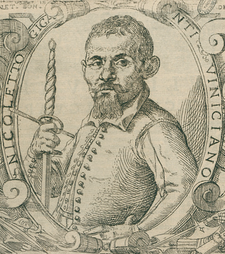 | |
| Born | 1550s-60s Fossombrone, Italy |
| Died | date of death unknown |
| Occupation |
|
| Nationality | Italian |
| Citizenship | Republic of Venice |
| Patron |
|
| Influenced | Bondì di Mazo (?) |
| Genres | Fencing manual |
| Language | Italian |
| Notable work(s) |
|
| First printed english edition |
Leoni, 2010 |
| Concordance by | Michael Chidester |
Nicoletto Giganti (Niccoletto, Nicolat) was an Italian soldier and fencing master around the turn of the 17th century. He was likely born to a noble family in Fossombrone in central Italy,[1] and only later became a citizen of Venice.[2] Little is known of Giganti’s life, but in the dedication to his 1606 treatise he claims 27 years of professional experience, meaning that his career began in 1579 (possibly referring to service in the Venetian military, a long tradition of the Giganti family).[1] Additionally, the preface to his 1608 treatise describes him as a Master of Arms to the Order of Santo Stefano in Pisa, a powerful military order founded by Cosimo I de' Medici, giving some further clues to his career.
In 1606, Giganti published a treatise on the use of the rapier (both single and with the dagger) titled Scola, overo teatro ("School, or Theater"). It is dedicated to Cosimo II de' Medici. This treatise is structured as a series of progressively more complex lessons, and Tom Leoni opines that this treatise is the best pedagogical work on rapier fencing of the early 17th century.[3] It is also the first treatise to fully articulate the principle of the lunge. Giganti also promised in this book that he would publish a second volume, a pledge he made good on in 1608.[4] Titled Libro secondo di Niccoletto Giganti ("Second Book of Niccoletto Giganti"), it is dedicated to Christofano Chigi, a Knight of Malta, and covers the same weapons as the first as well as rapier and buckler, rapier and cloak, rapier and shield, single dagger, and mixed weapon encounters. This text in turn promises additional writings on the dagger and on cutting with the rapier, but there is no record of further books by Giganti ever being published.
While Giganti's second book quickly disappeared from history, his first seems to have been quite popular: reprints, mostly unauthorized, sprang up many times over the subsequent decades, both in the original Italian and, beginning in 1619, in French and German translations. The 1622 edition of this unauthorized dual-language edition also included book 2 of Salvator Fabris' 1606 treatise Lo Schermo, overo Scienza d’Arme[5] which, coupled with the loss of Giganti's true second book, is probably what has lead many later bibliographers to accuse Giganti himself of plagiarism.[6]
Contents
Treatise
Giganti, like many 17th century authors, had a tendency to write incredibly long, multi-page paragraphs which quickly become hard to follow. Jacob de Zeter's 1619 dual-language edition often breaks these up into more manageable chunks, and in this concordance his paragraph breaks have also been applied to the Italian and English.
A copy of the 1628 printing of the first book which now resides in the Österreichische Nationalbibliothek was extensively annotated by a contemporary reader. Its annotations are beyond the scope of this concordance, but they have been transcribed by Julian Schrattenecker and Florian Fortner, and incorporated into Jeff Vansteenkiste's translation in a separate document.
For further information, including transcription and translation notes, see the discussion page.
| Work | Author(s) | Source | License |
|---|---|---|---|
| Illustrations | Odoarco Fialetti | Corble Collection | |
| Translation | Jeff Vansteenkiste | Il labirinto | |
| Transcription (1606) | Jeff Vansteenkiste | Index:Scola, overo teatro (Nicoletto Giganti) | |
| Transcription (1608) | Benjamin Keiller | Index:Libro secondo (Nicoletto Giganti) | |
| German Transcription (1619) | Jan Schäfer | Index:Escrime Novvelle ou Theatre (Nicoletto Giganti) Book 1 | |
| French Transcription (1619) | Olivier Delannoy | Index:Escrime Novvelle ou Theatre (Nicoletto Giganti) Book 1 |
Additional Resources
The following is a list of publications containing scans, transcriptions, and translations relevant to this article, as well as published peer-reviewed research.
- Giganti, Nicoletto (2010). Venetian Rapier: The School, or Salle. Nicoletto Giganti's 1606 Rapier Fencing Curriculum. Trans. by Tom Leoni. Wheaton, IL: Freelance Academy Press. ISBN 978-0-9825911-2-3.
- Giganti, Nicoletto (2013). The 'Lost' Second Book of Nicoletto Giganti (1608): A Rapier Fencing Treatise. Trans. by Piermarco Terminiello and Joshua Pendragon. Vulpes. ISBN 978-1909348318.
- Giganti, Nicoletto (2014). Nicoletto Giganti's the School of the Sword: A New Translation by Aaron Taylor Miedema. Trans. by Aaron Taylor Miedema. Legacy Books Press. ISBN 978-1927537077.
References
- ↑ 1.0 1.1 Giganti 2013, p 9.
- ↑ That he eventually became a Venetian citizen is indicated on the title page of his 1606 treatise.
- ↑ Giganti 2010, p xi.
- ↑ This treatise was considered lost for centuries, and as early as 1673 the Sicilian master Giuseppe Morsicato Pallavicini stated that this second book was never published at all. See La seconda parte della scherma illustrata. Palermo, 1673. p V.
- ↑ It's possible that the 1619 did as well, but there are no surviving copies that include it so we have to assume it didn't.
- ↑ This accusation was first made by Johann Joachim Hynitzsch, who attributed the edition to Giganti rather than Zeter and was incensed that he gave no credit to Fabris.
- ↑ Although the plates depicting the guards and counterguards are somewhat less than clear, we know from this chapter that Figure 2 depicts binding the enemy’s sword on the inside.
- ↑ Figure 3, which we know from the description of this chapter’s action depicts binding the enemy’s sword on the outside.
- ↑ Reading the text, Figures 6 and 7 appear to be swapped, meaning this lesson’s text refers to Figure 7. Interestingly, the plate order does not appear to be corrected in subsequent printings, even in Jakob de Zeter’s German/French version (1619), which uses entirely new plates created by a different artist.
- ↑ This lesson’s text refers to Figure 6.
- ↑ The two fencers.
- ↑ The placeholder was never replaced with the proper figure number reference when the book went to print, and it remains missing in Paolo Frambotto’s 1628 reprint. Jakob de Zeter’s 1619 German/French version refers to Figure 7.
- ↑ This is the second manner mentioned at the beginning of the lesson, rather than an action that follows from the first.
- ↑ Camillo Agrippa (1553), for example, recommends turning the face away.
- ↑ The two preceding figures.
- ↑ The original text is “vorreste”, or “you would like”. As our fencer’s opponent is the one with the dagger, it is likely that this is a mistake in the text.
- ↑ The figure number is missing in both the 1606 and 1628 printings. Jakob de Zeter’s 1619 German/French version refers to Figure 21.
- ↑ 18.0 18.1 18.2 Figure 21.
- ↑ The guard Giganti refers to here is unclear.
- ↑ 20.0 20.1 Figures 21–26.
- ↑ The original text uses the words “in varia”, or “in varying”. This is likely an error in the text which should read “in aria”, or “in the air”, and has been corrected here.
- ↑ The figure number is missing in both the 1606 and 1628 printings. Jakob de Zeter’s 1619 German/French version also omits a figure reference. The anonymous notes in the Vienna copy state that it is the 21st figure.
- ↑ The figure number is missing in both the 1606 and 1628 printings. Jakob de Zeter’s 1619 German/French version refers to Figure 27.
- ↑ Scannare—to slaughter or cut the throat of.
- ↑ en or on

